Jazz seeks greener pastures after putting lesson with Tiger’s coach
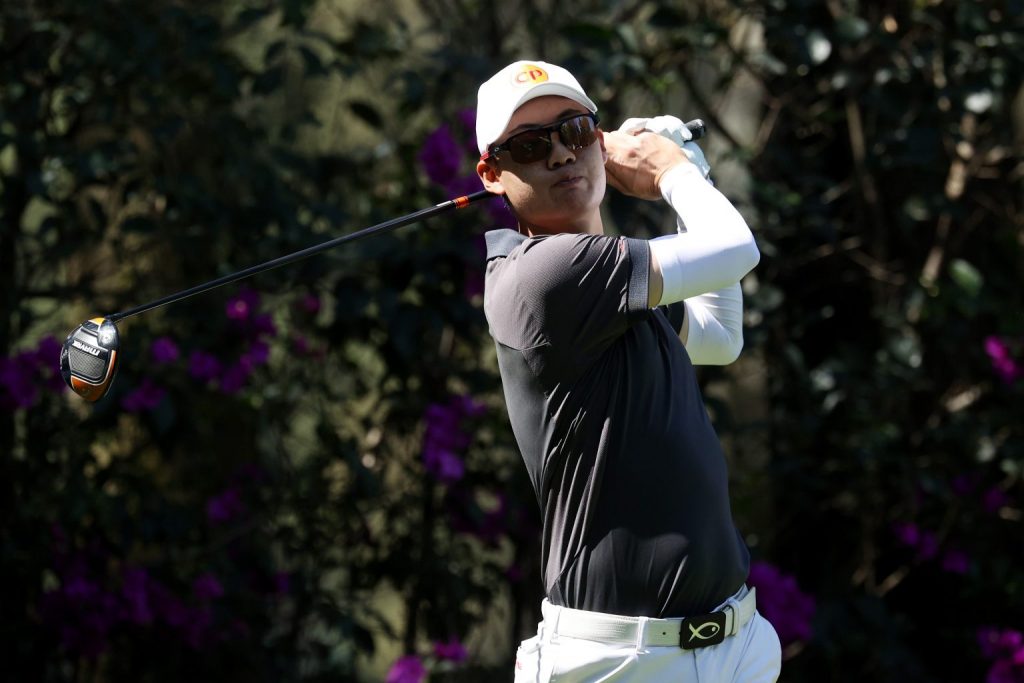
July 10: Thailand’s Jazz Janewattanond hopes a recent golf lesson with Tiger Woods’ putting coach will lift his fortunes as he prepares for the Memorial Tournament presented by Nationwide and World Golf Championships-FedEx St Jude Invitational later this month.
The 24-year-old rising star, who has been in the U.S. since March, was disappointed to miss the halfway cut at the Charles Schwab Challenge and RBC Heritage by one shot and two shots respectively when the PGA TOUR made a welcome return last month following a 91-day hiatus due to Covid-19.
After struggling with a cold putter, where he currently ranks 149th in Strokes Gained: Putting, Jazz sought the advice of Matt Killen, whose star pupils include 82-time PGA TOUR winner Woods and 2017 FedExCup champion, Justin Thomas.
“It would have been nice to play the weekends. I struggled with my putting and lost so many strokes on the greens,” said the Thai, who is ranked 44th in the world on the back of a four-win season on the Asian Tour last year.
Being part of the same management stable as Woods and Thomas has its fringe benefits. When Jazz discussed with his manager his putting woes, Killen’s name was put forward and Jazz flew out to Nashville last week for a three-hour lesson in putting.
“It was a really good three hours spent with Matt. When you see a guy who works with successful players, it gives you the confidence you can trust him. So I’m just following what he’s asking me to do,” said Jazz.
Killen did not tweak Jazz’s putting technique or stroke, especially when the Thai had ranked second for putting average (greens in regulation) on the Asian Tour last season. Instead, the instructor showed Jazz several drills to help him adapt quicker to the intricacies of new greens, considering Jazz will be playing on many golf courses for the first time through his exemptions on the PGA TOUR this year.
“For me, it’s not a technique thing. Matt has taught me how to practice and perceive the putting greens when I get to a tournament site. What we did was to learn how to set up a drill when I get to a new course and work on getting familiarise to the greens,” he said.
With the WGC-FedEx St Jude Invitational being played over four rounds without a 36-hole cut, Jazz hopes to master the putting surfaces at TPC Southwind in Memphis, Tennessee from July 30 to August 2 with the aim of putting up a good result.
“For sure, it’ll be a different mindset for the WGC. You don’t need to worry about the cut and you can have go from the start. You can be more aggressive, which frees your mind up a little bit. I’m glad to be in the field and hope to play well,” said Jazz.
He is also looking forward to meeting golf legend Jack Nicklaus, host of the Memorial Tournament at Muirfield Village, Ohio next week. With Woods confirmed to play at Muirfield where he has won five times previously, Jazz is pumped up.
“I’ve heard a lot of good things about Jack’s place and I’m excited to play there. I’ve read about Jack a lot, obviously the greatest player with 18 major wins. Growing up, it has always been Tiger vs Jack’s record and it’ll be special to be able to meet Jack,” he said.
With the PGA TOUR observing strict protocols under its Health and Safety Plan for tournaments to resume play, Jazz has felt at ease during the first two events. “I have felt safe … it was all good. I also usually eat take-outs so it was fine. There was no issue at all for me.
“Without crowds on site, it does feel a bit different. It’s good we have some volunteers on the course and they are cheering for good shots. We had all the best players for the first two events and it felt like being in a major.”
He is still determined to earn his card on the PGA TOUR through the non-member FedExCup points list. “I won’t give it up. All it takes is one or two good weeks. Who knows what can happen in this game? I’m just going to keep having fun and enjoy myself every time I’m out competing.”
Fans in Thailand will be able to watch the Memorial Tournament and WGC-FedEx St Jude Invitational on Golf Channel Thailand and GOLFTV powered by PGA TOUR.
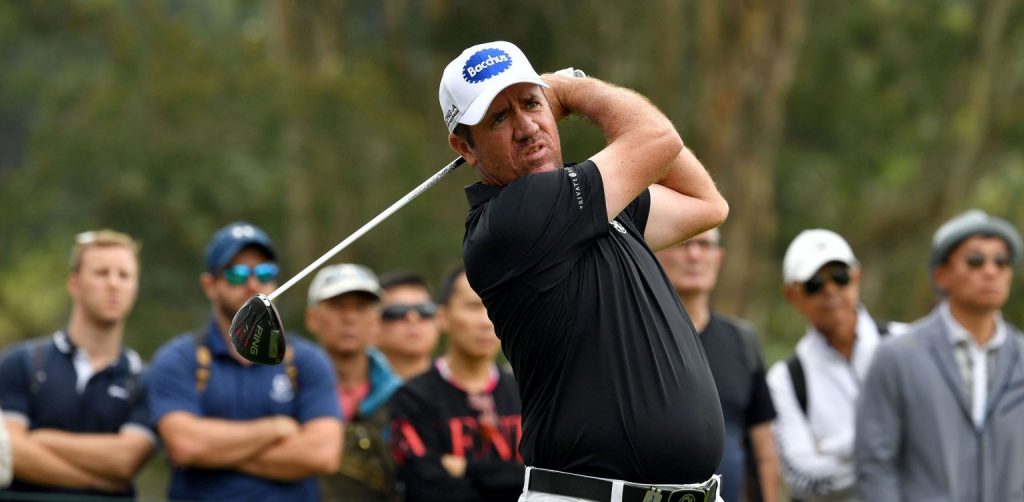
Australian Scott Hend is presently at home in Florida getting ready for the restart of the European Tour and their new ‘UK swing’ later this month. The 10-time Asian Tour winner – who is slated to make his fourth appearance at US Open in September – is raring to go and, during a time of reflection for many, he spoke to Simon Wilson about his rise to become one of the region’s most prolific winners.
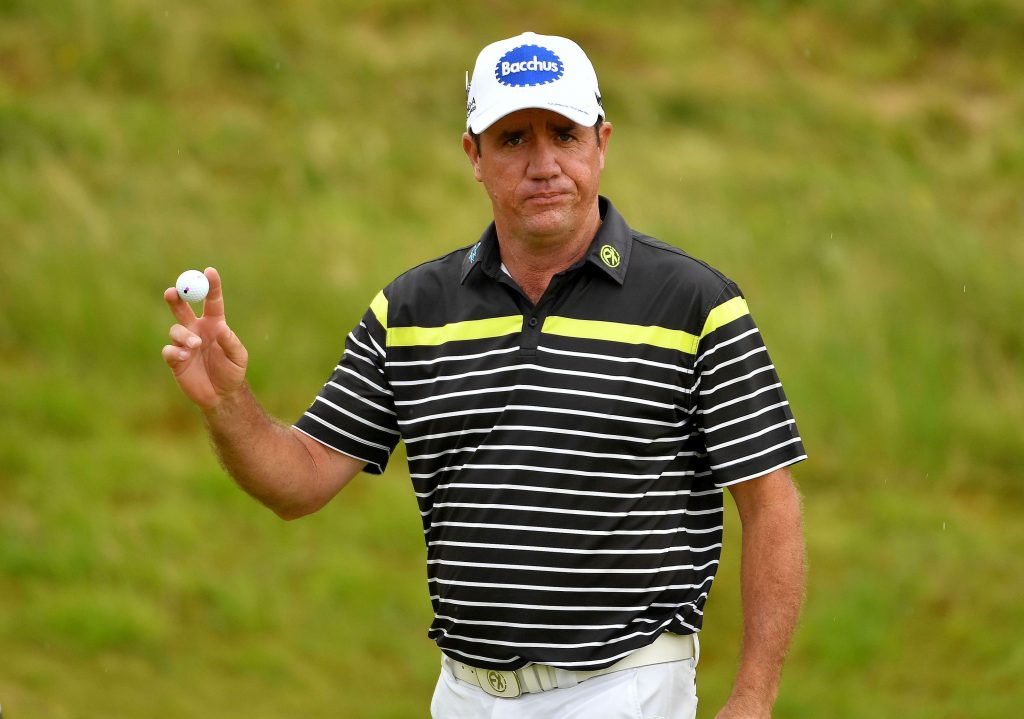
SOUTHPORT-ENGLAND – The 146th Open Championship at the Royal Birkdale Golf Club, July 20-23, 2017. Picture by Paul Lakatos/Asian Tour.
When Scott Hend was growing up in Australia and first started to think about making a career out of golf, he says: “I just wanted to play golf for a living. I didn’t think about winning events or how many I could win. I just wanted to play … on golf courses everywhere.”
Perhaps this was just cautious optimism but whatever the strategy he went on to achieve those early ambitions and so much more.
If, back then, he had said: “I want to become one of the most successful players in the history of the Asian Tour, win 10 events there, win on the European Tour and in Australia, play on the PGA Tour, and compete for my country in the Olympics”, well then he would have been a golfing prophet, as all those boxes have also been ticked.
To put it simply, the Australian has been, arguably, the most dominant player on the Asian Tour for the past 13 years and monopolized the Order of Merit list.
In 2016, he became the first Australian to win the Merit title and, impressively, he also finished second on three occasions – in 2013, 2015 and 2019 – and was fourth four times – in 2007, 2009, 2014 and 2017.
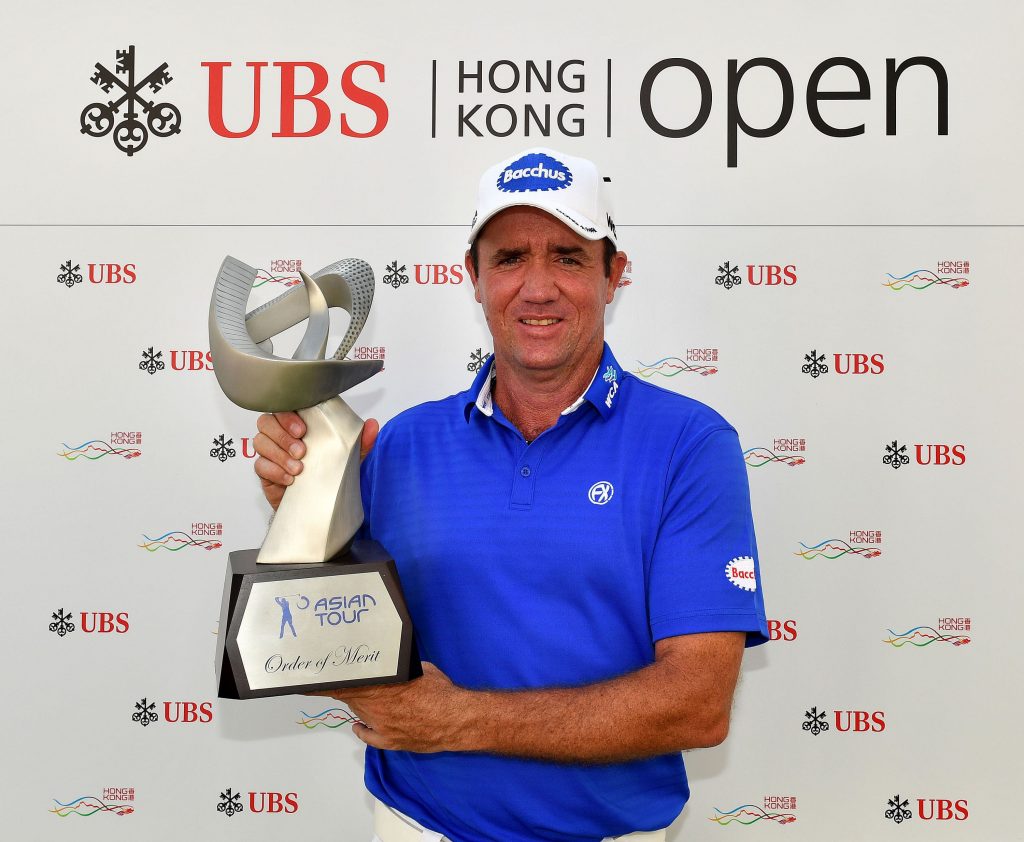
Hend was crowned the 2016 Order of Merit champion following the conclusion of Hong Kong Open that year. Picture by Paul Lakatos/Asian Tour.
And when he claimed his 10th Asian Tour title in March 2019 – the Maybank Championship in Malaysia – he moved into second place on the Career Money List.
He is still in second place today with earnings of US$5,084,342 while trailblazing Thai golfer Thongchai Jaidee – a 13-time winner on the Tour – leads the way with winnings of US$5,744,337.
With an innate ability to hit the golf ball prodigious distances, he has harnessed that raw power to devastating effect and beaten some of the best players in the world.
“When I was taught to play golf I was told to hit it as hard as you can,” says Hend, who represented Australia in the 2016 Rio Olympics along with Marcus Fraser.

RIO DE JANEIRO, BRAZIL – AUGUST 08: Scott Hend of Australia in front of the Olympic rings during a practice round at Olympic Golf Course on August 8, 2016 in Rio de Janeiro, Brazil. (Photo by Ross Kinnaird/Getty Images)
“I have been fortunate since I started playing golf to be able to create some decent club-head speed. Not everybody can do that. I am lucky, I have been able to do that and stay relatively injury free. But these days I am more like an average length compared to all the young guys.”
The Australian also had an operation in 2012 to remove an overactive thyroid – which he feels helped his game as it calmed his sometimes fiery persona.
For the moment though, the coronavirus pandemic and its resulting restrictions around the globe have put his playing schedule on hold.
“This is easily the longest break I have had in 26 years,” says the 46-year-old Queenslander.
“It has been okay but it has also been frustrating. Not being able to play tournaments for me has been a very frustrating thing. There is nothing we can do about it. Guys get injured for six or seven weeks but four months feels like forever!”
He was at the Qatar Masters in early March but had to withdraw through an injury and decided to head to Bangkok for treatment.
His wife Leanne and teenage twins Aston and McLaren – yes, he is a lover of fast cars – joined him there on March 20 and it was on that day, when they landed, that Asia basically went into lockdown.
They ended up staying there for two months before being able to buy new tickets to get home to Florida, where he is based since 2003.
He said: “We thought we would just get home as opposed to staying in a friend’s apartment”.
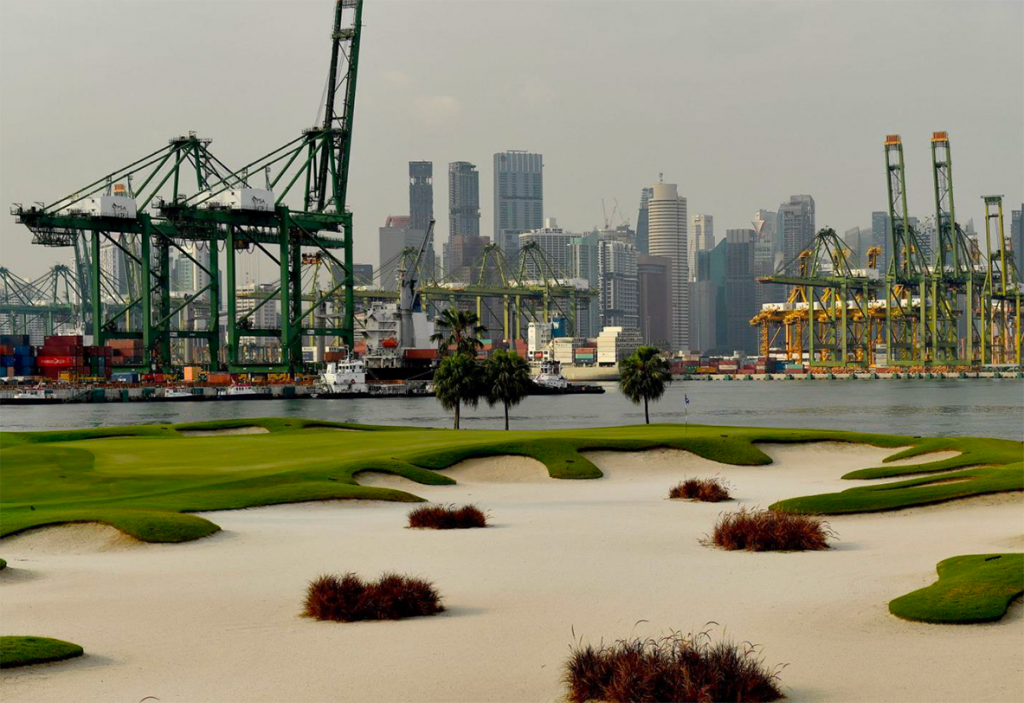
CRANS-MONTANA, SWITZERLAND – SEPTEMBER 10: Scott Hend of Australia lines up a putt as his wife/caddie Leanne Hend looks on at the Omega European Masters at Crans-sur-Sierre Golf Club on September 10, 2017 in Crans-Montana, Switzerland. (Photo by Stuart Franklin/Getty Images)
“Since the European Tour announced they will return for the UK swing I have been back out the last two-and-a-half weeks solidly hitting balls every day trying to get back into it. Hitting golf balls and playing golf are two completely different things. It is going to be interesting when we actually get on the golf course and play,” added Hend.
He plans to fly to the UK on July 17 for a six-week stretch, where his caddie for the past seven years and former Tour professional Tony Carolan will join him.
They will then fly back to America to prepare for what will be his fourth appearance in the US Open – which is being played at Winged Foot Golf Club in New York from September 17-20.
They are returning to the United States two weeks before the tournament just in case they have to quarantine.
The 120th US Open has allocated one spot to the top finisher of the 2019 Asian Tour Order of Merit. With reigning Merit champion Jazz Janewattananond already exempt through his Official World Golf Ranking in March, second-placed Hend will take the coveted spot in the prestigious event where he made his Major debut in 2004.
“It is going to be pretty cool. The last time I played Winged Foot was in the 2006 US Open and Geoff Ogilvy won, I finished T32,” he said.
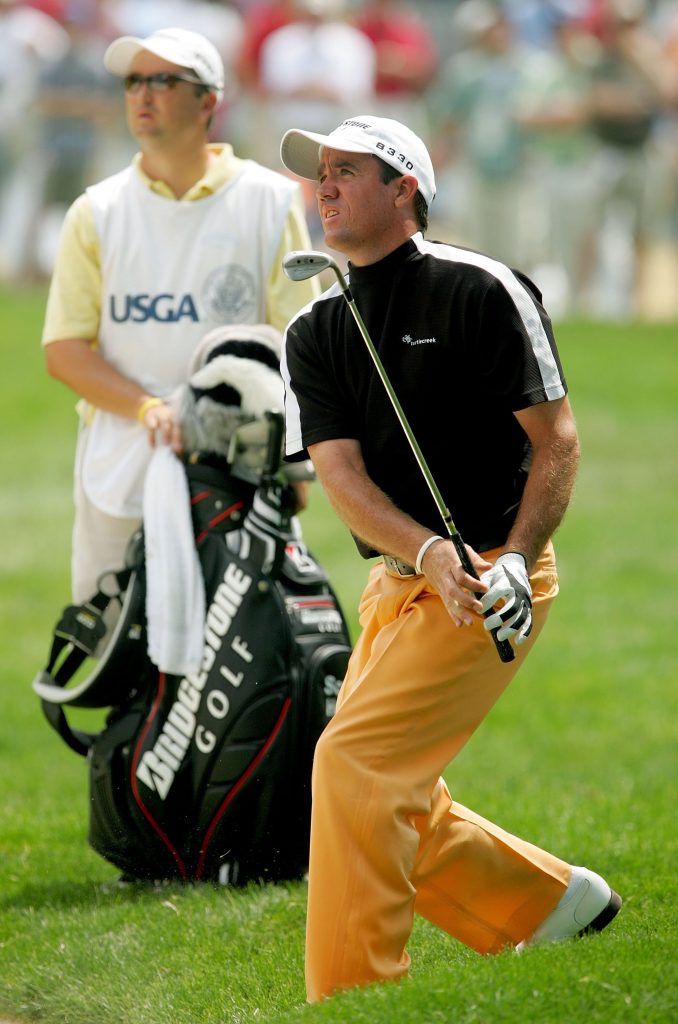
MAMARONECK, NY – JUNE 17: Scott Hend of Australia hits a shot as his caddie Ray Farnell looks on during the third round of the 2006 US Open Championship at Winged Foot Golf Club on June 17, 2006 in Mamaroneck, New York. (Photo by Jamie Squire/Getty Images)
Exactly when he will be able to return and play on the Asian Tour will be determined over the coming months, when the situation here becomes clearer.
His time spent in Asia has brought rich rewards, instilled a belief in his game and been at the heart of his success as a Tour professional.
Early on in his career, he played on the Canadian Tour for many years – winning the Victoria Open in 2002 – before deciding play on the PGA Tour in 2004, which was when he bought a house in Florida and as he says: “set up shop there”.
But after two seasons, injuries (wrist) and playing poorly saw him lose his playing rights and he turned his attention to the Far East and the Asian Tour Qualifying School in 2006.
“I finished second to Ben Leong (at the Qualifying School). My kids were born in December 2006 and then I went straight to Pakistan and finished second and from there on it was ‘happy days’ on the Asian Tour,” says Hend.
His first win came in 2008 at the Pertamina Indonesia Presidents Invitational while his most recent was the 2019 Maybank Championship.
He enjoyed a bumper year in 2013 claiming three titles: in the Chiangmai Golf Classic, the Mercuries Taiwan Masters, and the Macau Open.
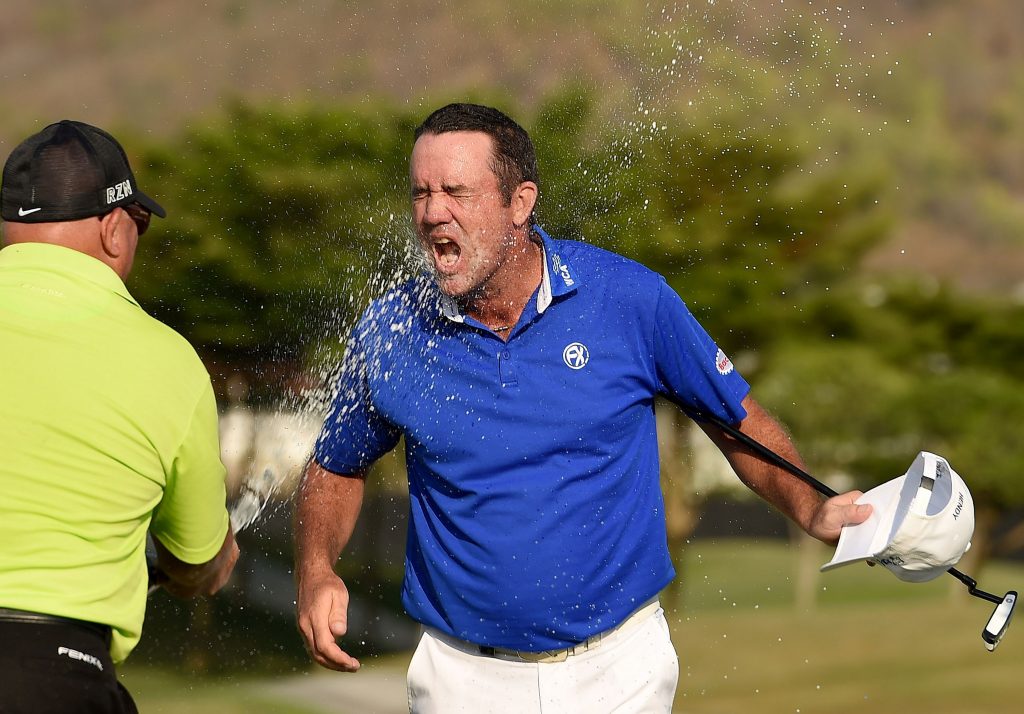
HUA HIN – THAILAND – Scott Hend of Australia is sprayed with champagne on the 18th green on Sunday March 13, 2016 during the final round of the True Thailand Classic presented by Chang at Black Mountain Golf Club, Hua Hin, Thailand. A USD$ 1.75 million event co-sanctioned with the European and Asian Tour. Picture by Paul Lakatos/Asian Tour.
But he rates his win in the Hong Kong Open in 2014 as his finest as it was jointly-sanctioned with the European Tour and allowed him to earn his card there for the first time. He is also extremely proud to have won an event steeped in history, boasting so many great Australians as past champions.
“I have a lot of friends in Asia, I like the people, I like the food, and the golf courses are quite similar to where I grew up in Australia. The grasses are very similar. It is not like I am in a strange world. Australia is very close to Asia so it is very similar,” says Hend.
The Australian came so close to winning the Omega European Masters in 2016 and 2017 but lost both times in sudden-death play-off, to Swede Alex Noren and then Matthew Fitzpatrick from England.
“The first one wasn’t that bad because Alex holed a fantastic putt to win but that second one took a lot longer for me to get over because I hit a putt where I thought I should have but I just mis-read it. The second loss was extremely disappointing. It took a fair while to get over that and to start playing good golf again.
“I don’t normally let these things bother me but for some reason that one did. I guess because it was two years in a row and I really, really wanted to win there as I love the place and I really want to win on European soil. The second one was a bit more telling with a bit of a sting in the tail.”
But Hend, having been a professional since 1997, been a member of at least five Tours and won 15 tournaments around the world, has experience in abundance and is philosophical about his career.
He says: “This is the profession we are in, it’s quite volatile, there are lot of guys around the world every year trying to get to a certain place there are only a certain amount of spots and you have to be a realist about it. That’s the way it goes, sometimes you can’t get what you want. Then you just have to work hard and you find other ways to make a living and other Tours to play.
“I am very lucky, I am very fortunate to be able to do this. I get to travel all year and see things, so in that regard my job is quite special. I feel very lucky to be good enough at it to do that.”
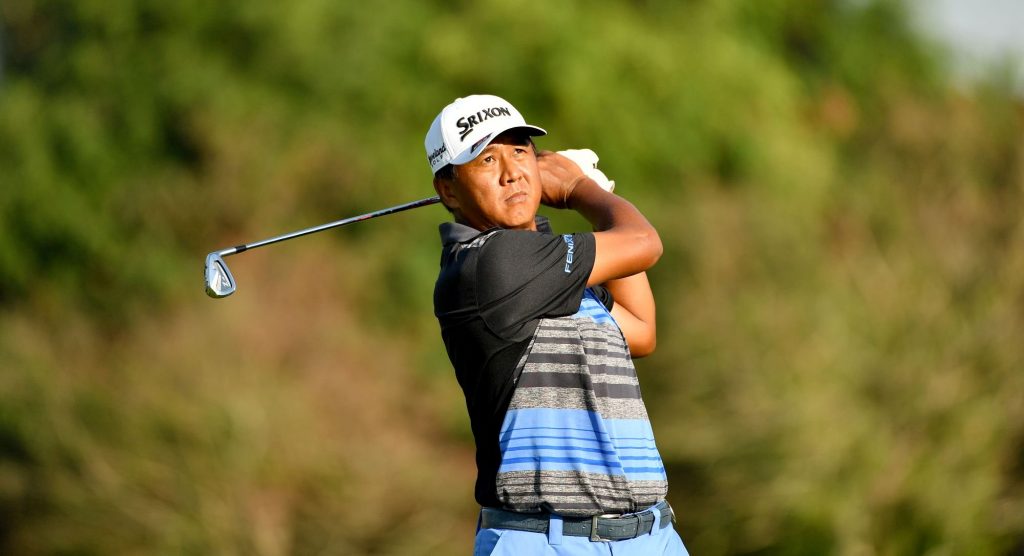
Zaw Moe, the Myanmar golfer who has made Singapore his home for nearly 30 years, turned 53 at the weekend. Simon Wilson caught up with the Asian and Japan Tour veteran to discuss the many highlights of his distinguished career.
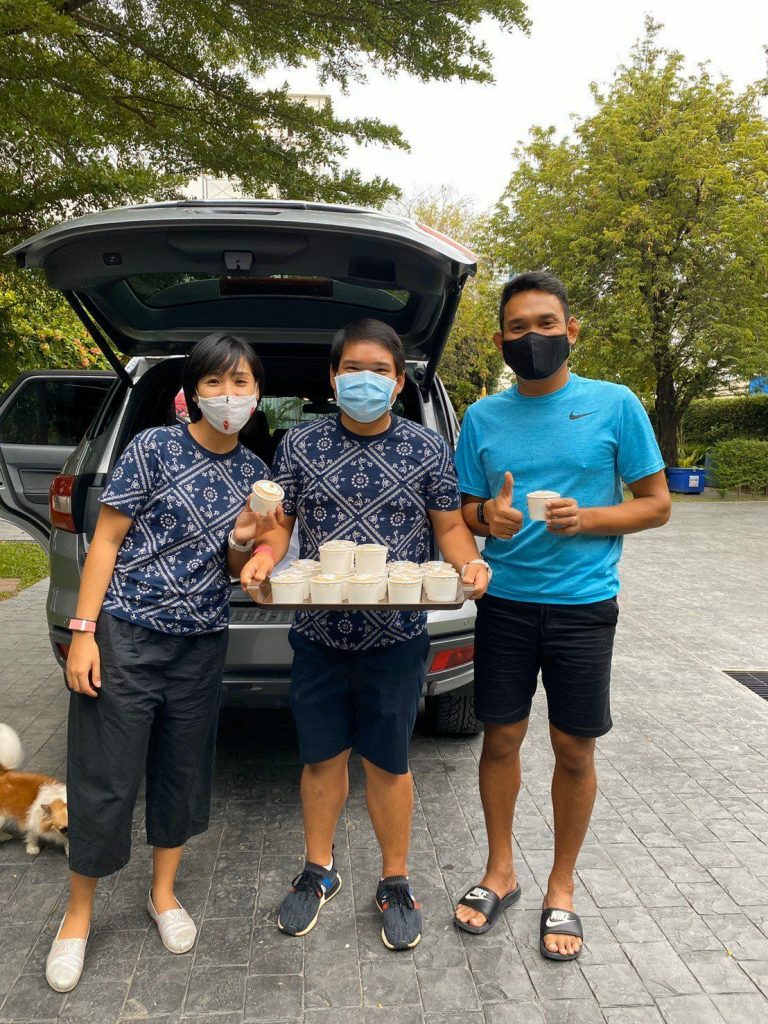
When Zaw Moe launched one of his long, trademark drives – just over 290 yards – on Thai Country Club’s 17th hole in the Asian Honda Classic, in February 1997, it brought rapturous applause from the huge gallery assembled there.
It was the kind of moment the young-man from Myanmar lived for, but this was a particularly exceptional occasion: it was the final round, the final pairing and, thrust into the global spotlight, he was playing with a rookie professional who was to shape the game of golf like no other: Tiger Woods.
The American, aged just 21, was playing in Thailand for the first time as a professional and having already claimed three PGA Tour titles, he arrived with much expectation, fanfare and at times uncontrollable excitement.
During an unprecedented week – the likes of which had never before been seen in Asia – Woods dominated from start to finish: he had a six-shot lead at the start of the day and won by 10! It proved to be a warning shot to the world as two months later he claimed the first of his five US Masters titles by 12 strokes!
However, on that penultimate hole at Thai Country Club just outside Bangkok, Woods did make a rare mistake when he pushed his tee shot into water on the right.
“I could see he was angry,” recalls Zaw.
“He told ‘Fluff’ (Mike Cowan) his caddie to give him another ball as he wanted to hit from the tee as opposed to taking a drop. He then drove 30 yards past me. Then, I hit five wood for my second to the green but he hit six iron.
“And on 18 I hit another great tee shot but he hit a two-iron as far as my driver. He was on a different level and I realized I was just a spectator as the round went on.”
With wildly enthusiastic crowds all around him, Zaw did well to record a top-20 finish.
While the result was not what he was looking for, it was another giant moment in the career of Zaw.
The tall golfer with a much-admired, silky-smooth swing is one of his nation’s finest sporting exports who boasts an outstanding record on both the Asian Tour and Japan Golf Tour Organization – he played on the latter circuit with great success for nearly 10 years starting from 1996.
He has claimed 21 titles in the region including the 1997 Singapore Open at Jurong Country Club and early on in his career, he dominated the local Malaysian circuit claiming three Order of Merit titles.

Zaw Moe lifting the Singapore Open trophy in 1997.
Moe is part of the “Great Triumvirate” of pioneering golfers from Myanmar, along with Mya Aye and Kyi Hla Han.
Mya Aye was the first to make a mark for Myanmar in the 1970s and won six times in the region.
And Han, the country’s greatest golfer, followed not long after – finding a home for many of the region’s most prestigious trophies and becoming Asian Tour Order of Merit champion in 1999.
All three are also past winners of the Singapore Open: Mya Aye claimed the title in 1981 and Han in 1994.
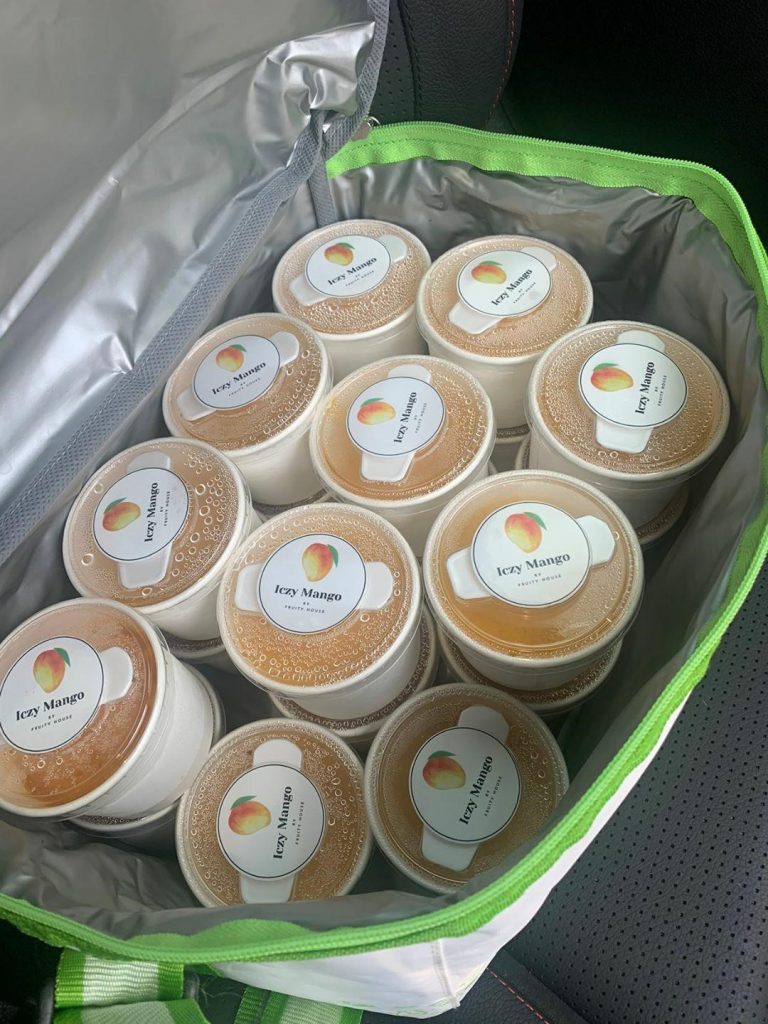
Zaw Moe with fellow countryman Kyi Hla Han (left).
It is one of the Asian Tour’s most appealing and enduring qualities that, through its diversity, it has facilitated the emergence of elite players from countries that, perhaps, you would least expect.
Myanmar is one such nation that few would expect to contribute to Asia’s golfing landscape, but it most certainly has done and continues to do so.
Zaw turned professional in 1989 and it didn’t take long for him to find his feet in the game, despite facing the daunting prospect of heading on the road as a Touring professional, aged just 22, and with very limited resources.
“When I turned professional and first came out of Myanmar I only had US$700 in my pocket, plus one golf set and a suitcase,” said Zaw, who was born in Lashio – in Myanmar’s Shan State, where his father was the Chief Engineer.
“I was heading to stay with Chan Han (Kyi Hla Han’s brother) in Malaysia but could not get a visa so I had to stay in Bangkok for a month – where I spent US$200, so I was down to US$500.
“When I eventually got to Malaysia – where I planned to play on the domestic Malaysian circuit – I won about MYR1,300 in my first event in the Cameron Highlands. This was in December, 1989. Then, in my second event I finished third so I won about MYR1,700 and in my third event I lost in playoff so I won about MYR3,000. This was the ‘kick start’ to my career.”
With his confidence fortified by success in Malaysia he then chose to try his hand on the Asian Tour – which at that time was run by the Asia Pacific Golf Confederation and local Golf Associations.
It was in the days before they had a Qualifying School and formal Tour membership, so players had to enter Monday qualifying rounds.
Said Zaw: “I spent all my money and went back to Malaysia to stay with Chan and make money on the Malaysian circuit again.”
Zaw won dozens of events on the TDC Tour of Malaysia and it wasn’t long before his game was at the level required to compete regularly on the Asian Tour.
Initially, he lived in Penang before his sponsor, Pan-West, kindly helped him set up in Singapore – where he has been living since the early 90s.
And it was there where he soon recorded the biggest victory of his career.
“Since 1995 I had been playing well but I couldn’t win, so when I arrived at the Singapore Open I felt I was due,” said Zaw.
At the start of the final round, he was four in front of an imposing chasing pack that included Thailand’s Boonchu Ruangkit. But he prevailed comfortably finishing the tournament on 11 under, after rounds of 67, 69, 69 and 72, to win by three from American Fran Quinn and earn a cheque for US$80,750.
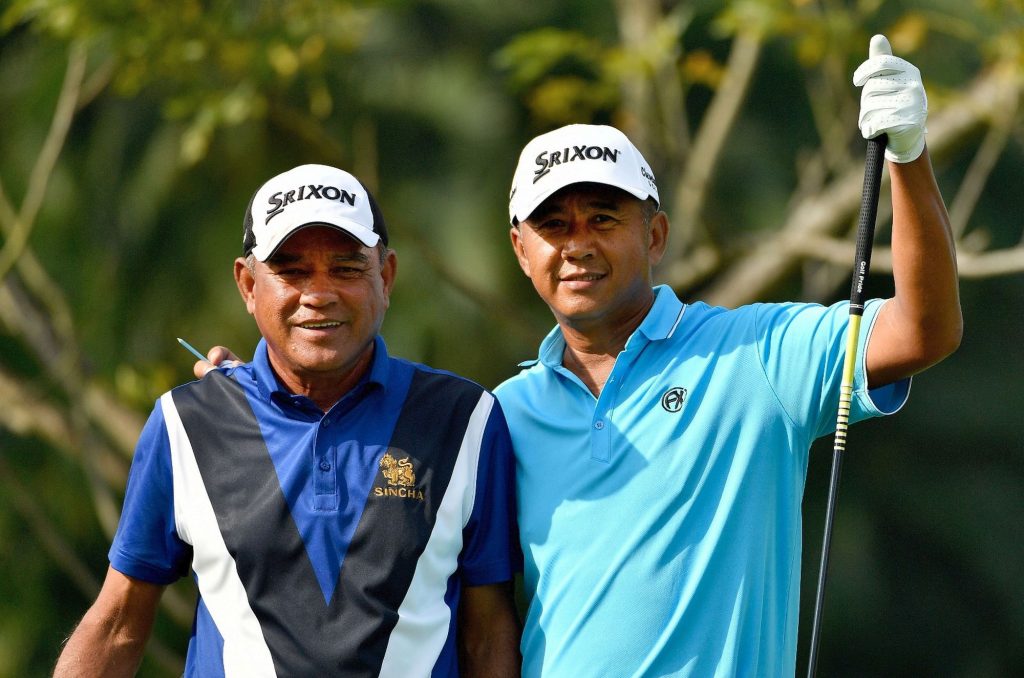
Zaw Moe with Thai legend Boonchu Ruangkit (left).
Many more victories were expected to follow but, remarkably, Moe lost in seven play-offs during his career: three on the Asian Tour and four in Japan.
“If I go and play now, I think I would win more. I was trying to be too perfect back then. I would have won more tournaments if I had just accepted myself. I was looking for the one perfect swing,” said Zaw.
“I was very technical. I was looking for the perfect swing and this was one of the biggest mistakes in my life. Everyone, like Mardan (Mamat), told me, God gave you a good swing, why did you go and change it? At the end of the day you have to rely on your old swing and keep the basics. That’s all you have to do.”
His quest for excellence saw him regularly travel to the United States to see the best coaches in the world, including: Butch Harmon, David Leadbetter, Robert Baker and Phil Ritson.
Zaw acknowledges that his penchant for perfection is more of an attribute these days as much of his time is spent teaching at Singapore Island Country Club.
“It’s actually a good thing now because I can pass all my experience on to my students,” said Zaw, who also coached the Myanmar national team in 2011.
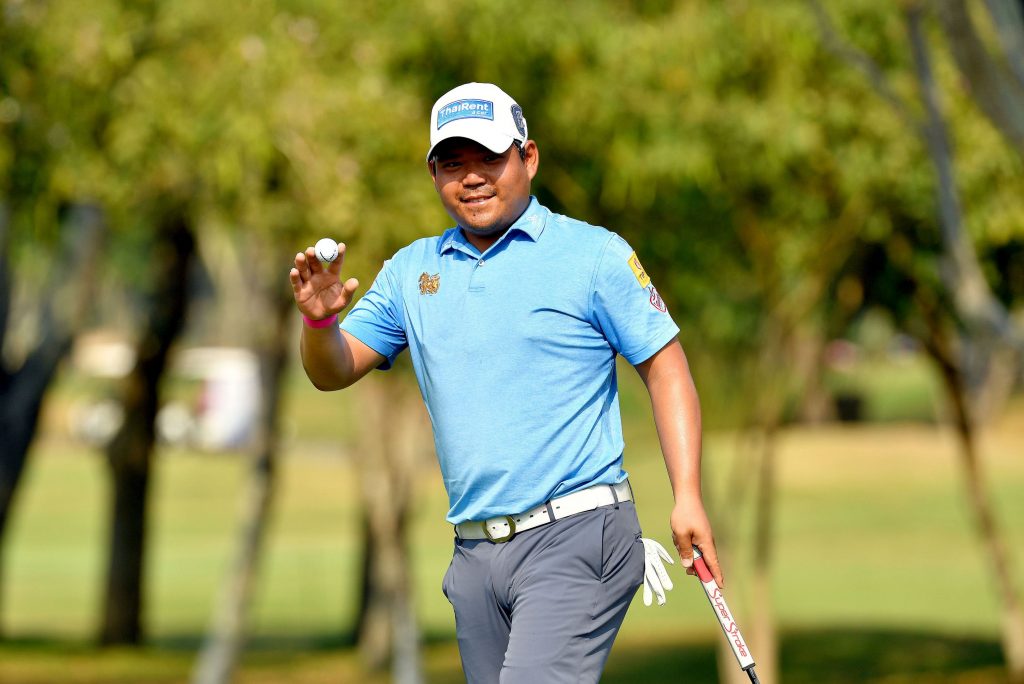
As well as a case of analysis paralysis Moe has also had more than a fair share of injuries.
He slipped a disc playing in the Johnnie Walker Classic in Thailand in 2003, which required an operation.
“After that my game went down in 2005. I stopped moving my body and was just swinging my hands and arms which is no good. And I lost it all,” he said.
And, in 2007, he had a liver infection – relating to a bout of Hepatitis C he got when growing up in Myanmar – which put him out of action for 13 months.
In 2015, he damaged his right wrist severely playing out of the rough at an Asian Tour event in Chiang Mai. He had to rest for six months, and that’s when he got more involved in teaching.
And much more recently, he fell over while jogging in Bishan Park in 2018 and broke his left knee and right wrist. He had just earned his Tour card for the Japan Seniors Tour and was due to fly out.
“When I fell over I also passed out but luckily a passer-by helped me back on to my feet so I was able to get home. I could have played 20 events that year,” he said.
He was also due to play in Japan this year but the coronavirus pandemic put pay to that.
Zaw’s wife Yukiko is Japanese but he has not been able to see her for months as she was in Japan when lockdown took effect.
He has been spending his time getting fit and losing weight in preparation for when he can play tournaments again and he has a busy teaching schedule.
Over the years, one of his students has been Cho Minn Thant – the Asian Tour Commissioner and CEO.
Zaw knows Cho, who grew up in Canberra but is from Myanmar, very well as he has been coaching him since he was 15 years old.
“Actually, he can play. But he didn’t play enough. He had the game but he never went out and tried it. So he didn’t know what his potential was. He hits the ball so long these days,” said Zaw.
Zaw certainly made the leap of faith, never looked back and earned his place as one of the legends of Asian golf.

It is hard to believe it has been 15 years since Singapore’s iconic National Open was first played on the hallowed turf of The Serapong at Sentosa Golf Club.
In that time, Sentosa Golf Club’s standing in the game globally has grown exponentially —buoyed by hosting other world-class events and being the recipient of countless awards.
This year, the majestic layout was due to undergo renovation work — allowing it to maintain its undoubted lead over its competitors.
But just as work started, everything came to a grinding halt in April when the nation was thrust into lockdown because of the Coronavirus Pandemic.
This, however, failed to affect the enthusiasm and energy of Andy Johnston — the General Manager and Director of Agronomy at Sentosa Golf Club — and the mastermind behind the successful growth and development of The Serapong and the venue’s second layout, The New Tanjong.
If anything, the pause in proceedings has steeled Johnston’s determination to make Serapong even greater.
“It’s going to be spectacular!” says Johnston, about plans for The Serapong when work restarts.
“As we know, this year has seen unprecedented circumstances that none of us could have predicted. We’re in the midst of a global pandemic where there are much bigger issues at play, and the health and safety of the world’s population is the number one priority.
“This has been our attitude when it has come to the renovations – if there’s a slight delay, so be it, however we must, and have, take the safety of our workforce, members, guests and the population of Singapore very seriously. Every industry and sector across the world has taken a hit with this situation and golf is no different.”
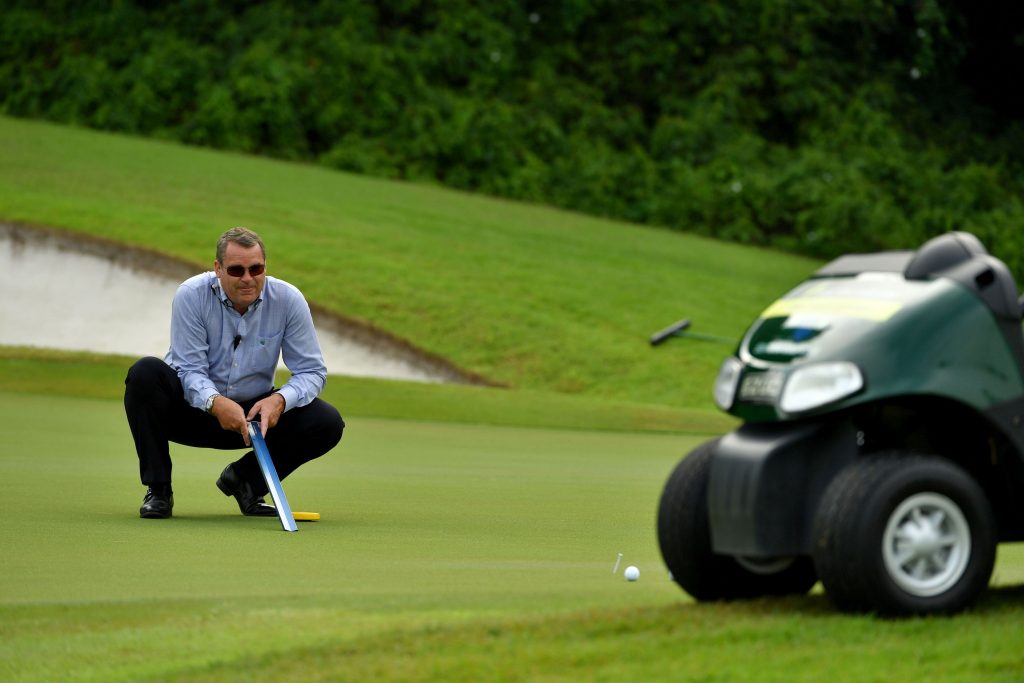
Andy Johnston, General Manager and Director of Agronomy at Sentosa Golf Club. Picture by Paul Lakatos/Lagardere Sports.
The upgrade of The Serapong was due to be a “three-month tactically planned operation”, which although delayed for the moment will quickly resume once the green light is given.
The operation, advanced and technical in true Sentosa fashion, is one that will further cement the course’s position in Golf Digest’s ‘Top 100 Greatest Golf Courses’ rankings — which moved up 20 places last year to reach 59th. The Serapong and The New Tanjong are also ranked first and second respectively on Golf Digest’s ‘Best Golf Courses in Singapore’ rankings.
The greens, famous for their speed and expanse, will undergo deep soil modifications with a drill and fill programme; this means the historic playing surfaces will not be disturbed.
This programme will see them drill large one-inch holes in the greens, 12 inches deep — a dynamic process to update the soil profile. Two special drill and fill machines were purchased from America last year and shipped over for the assignment.
Says Johnston: “This process will allow us to update and re-engineer the soil profile without removing the grass. The benefit will be a stronger, healthier surface that should be able to handle higher degrees of stress. And we all know what that means: harder, faster surfaces.”
In addition, all the grass on the fairways, and the bunker and green surrounds will be removed and replaced with new, clean Zoysia. Platinum Paspalum will be used for the new tees.
The areas will also be regraded, which includes the tees being re-lasered flat and widened back out into their original size, pointing down the fairway.
In addition, all bunker faces and shapes will be regraded and the bunkers will be replaced with new sand.
Johnston’s mission will be helped by the fact that he was in charge the last time the layout was remodelled in 2006. The course, designed by Ronald Fream and opened in 1982, underwent a S$12 million revamp, and reopened in time for Australian superstar Adam Scott to win the second of his three Singapore Open titles.
At the time Johnston was part of the Bates Golf Design team — who had been engaged to handle the project — but the American returned to the club on a full-time basis in 2010 as Director of Agronomy before becoming General Manager in 2013.
In 2019, the club enjoyed a celebrated year in terms of awards and when the latest remodeling is completed, there is no doubt more honours await.
The club was chosen as the ‘World’s Best Golf Club’ at The World Golf Awards at a special ceremony in Dubai; voted by the players on the Asian Tour as the ‘Best Golf Course on Tour’; gained a position in Platinum Clubs’ ‘World Top 100’; won the Golf Inc. ‘Environmental Stewardship Award of the Year’; and also achieved further success at The Asian Golf Awards winning the ‘Best Managed’, ‘Best Maintained’, ‘Best Food and Beverage’ and ‘Best Championship Course in Asia’ titles to claim their Grand Slam of awards.
The Asian Tour players also voted the SMBC Singapore Open the ‘Best Event on Tour’ for the second time in its history, following 2017.
The Awards — and the fact the club is home to the Asian Tour and the R&A, in Asia, headquarters — makes Johnston and his team feel “incredibly privileged”.
Says Johnston: “We are very proud of the team and our accomplishments, particularly in the last 12 months. When reviewing all of the awards and accolades that have come in during that time, there are many we can be very proud about.”
Perhaps one of the greatest accolades came earlier this year when American Matt Kuchar won the SMBC Singapore Open in January. The world’s leading players regularly praise the golf club and its facilities but “Kuch” was positively ecstatic about The Serapong saying the greens were some of “the best I have played on”.
“Not only were we proud to crown Matt Singapore Open Champion, but his vote of confidence was reassuring to us as we feel we belong amongst the world’s best and we are very proud to host the prestigious Asian Tour event. That host venue status is an honour in its own right,” added Johnston.
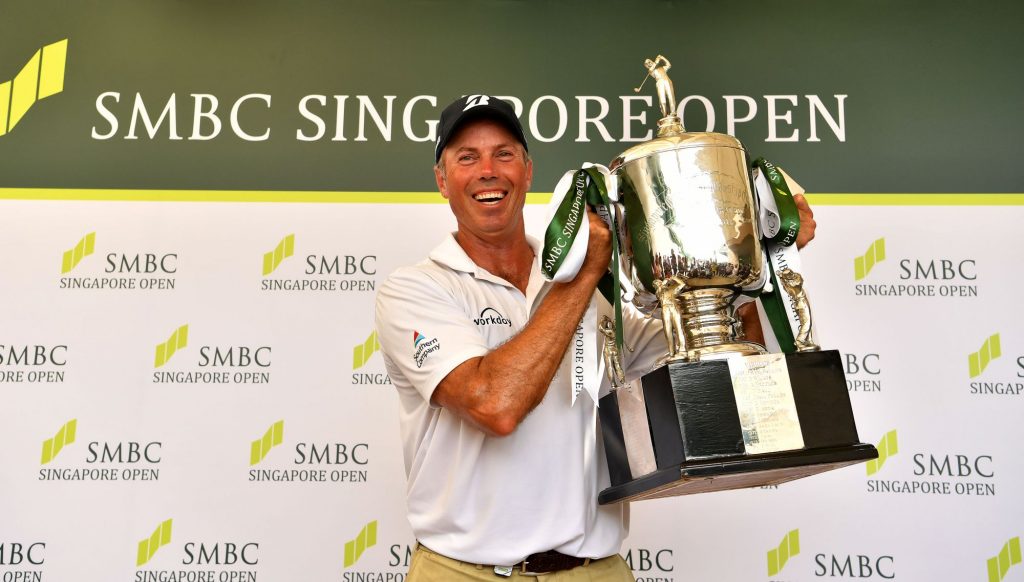
SINGAPORE- Matt Kuchar of the USA pictured with the winner’s trophy on Sunday January 19,2020, during the final round of the SMBC Singapore Open at the Sentosa Golf Club, Singapore. The USD$ 1 million event is co- sanctioned with the Asian Tour and Japan Tour, January 16-19, 2020. Picture by Paul Lakatos/Lagardére Sports.
Of course work will proceed with pace on all areas at the club once conditions permit and Johnston is quick to point out that their sustainability and #Keepitgreen campaign are a priority.
They are investing in biodigesters for both food and horticultural waste. The biodigesters will help convert the waste to plant food, which will then be spread back out onto the golf courses as fertiliser. And they also have ambitious plans to install a floating solar farm in the lagoon, implement electric car charging stations and they are currently working to join Group on Earth Observations (GEO) and become certified.
Says Johnston: “So, there’s lots more to come and plenty to be excited about when it comes to our green agenda. The sky is the limit really!”
He feels “that while it has been a real honour to have captured all of the accolades, in some ways it has become bigger than just Sentosa Golf Club or the golf course, as we are now representing the world of golf and our wonderful city.”
And while the world awaits to resume in the “new normal”, the American is prepared and looking forward to the challenges ahead.
“My role as General Manager and Director of Agronomy has not changed,” he says.
“The tremendous responsibility to take care of a property like this, and now even challenged more than ever with a reduced team, to use my time-earned intuitive skill to help stay ahead of what Mother Nature might send our way is a mission that is always never ending, and one I relish each and every day, when I am able to go to work every day to review and check on the grass and property. We just hope this all ends safely.”

On reaching the age of 50, which Korean icon K.J. Choi did last month (May 19), it is usual to take stock and reflect on your life achievements.
For Choi, one of the region’s golf greats and an honorary member of the Asian Tour, his performance statistics and the good deeds done by his Foundation tell the story of a dedicated professional and a committed humanitarian who has met his goals both on and off the course.
A quirk of fate that saw him switch from powerlifting to golf aged 16, a dog-eared copy of Jack Nicklaus’ instructional classic “Golf My Way”, a solitary golf club and an admirable work ethic combined to kick-start his glorious career.
Choi taught himself the game by leafing religiously through the pages of “Golf My Way” and putting into practice what the ‘Golden Bear’ preached. It was a slog on a course two hours by bus from his home with day-long sessions that stretched into months and years, culminating in Choi turning professional in 1994 aged 24.
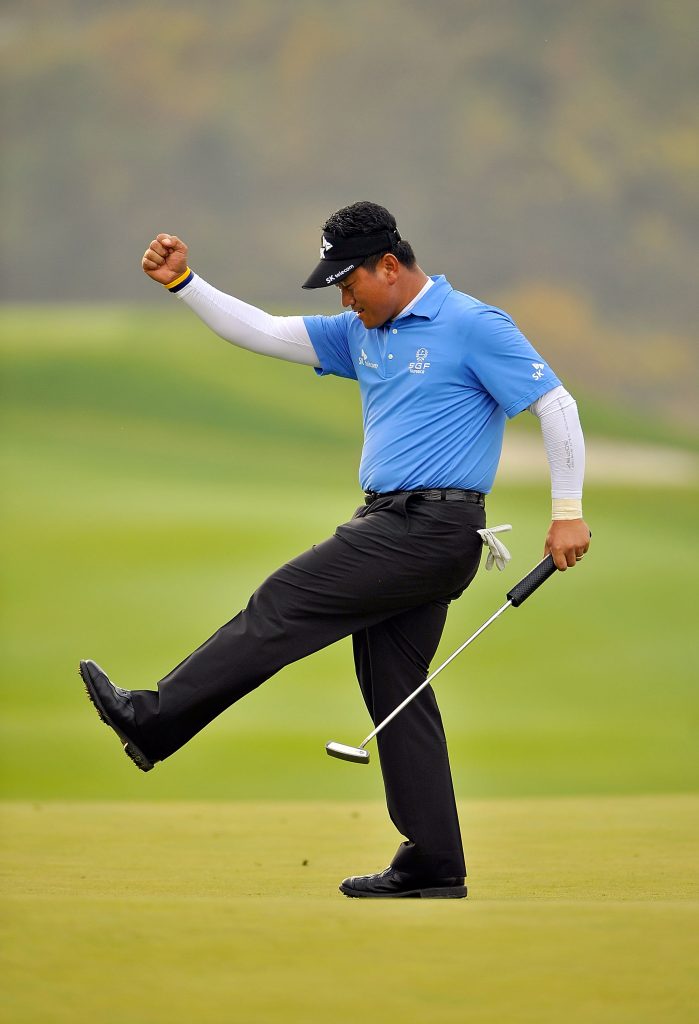
YEOJU-GUN, SOUTH KOREA – OCTOBER 23: K J Choi of Korea punches the air after a birdie on the 16th green during round four of the CJ Invitational at Haesley Nine Bridges Golf Club on October 23, 2011 in Yeoju-gun, South Korea. Photo by Paul Lakatos/Asian Tour.
He cut his competitive teeth on the Korean, Asian and Japan Tours. His won the 1996 Korean Open and after expanding his horizons beyond the Korean Tour won three times in 1999 – the Kirin Open and Ube Kosan Open (Japan Tour) and the Korean Open (Asian Tour), for a second time.
Choi became the first Korean to earn a card for the PGA Tour, via Q-School in 1999. Strikingly, Choi has played 468 tournaments on the circuit, won eight times, made 330 cuts and earned more than US$32.5 million.
Having hit his targets time and time again on the links, Choi has set himself a loftier challenge in society at large – ‘it is my life goal to help the children around me,’ he says.
To that end, his Foundation gives scholarships to less fortunate students to ensure they receive a college education.
Choi had planned to split his playing time between the PGA Tour and the Champions Tour from his base in the United States this year before the season was thrown into turmoil.
But Choi has not forgotten his roots and the opportunities afforded him by the Asian Tour as he improved his game to a level that marked him down as the ‘Asian player most likely to win a Major.’
On his frequent return visits to Asia, he has won several times including the Iskandar Johor Open in 2009 and the CJ Invitational in Korea back-to-back in 2011 and 2012.
Choi credits his time on the Asian Tour as the perfect proving ground for the PGA Tour.
“(My success) on the PGA Tour really stems from the years starting out in Korea, making my way gradually out into bigger arenas starting with the Asian Tour,” he said in a past interview.
“Definitely days competing on the Asian Tour really helped me a lot, I learned everywhere I went. All the tournaments I played I learned a lot and that was the foundation of my success (on the PGA Tour).”
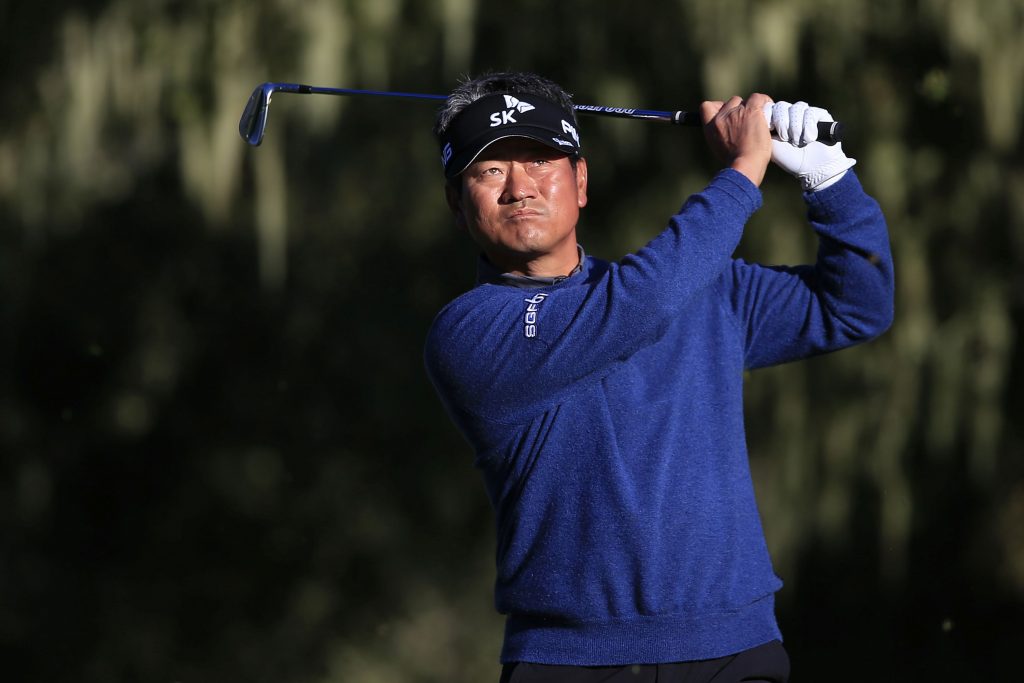
PEBBLE BEACH, CALIFORNIA – FEBRUARY 06: K.J. Choi of Korea plays his shot from the third tee during the during the first round of the AT&T Pebble Beach Pro-Am at Monterey Peninsula Country Club on February 06, 2020 in Pebble Beach, California. (Photo by Chris Trotman/Getty Images)
A goal-setter, Choi adopted the mantra of “to be the best, you’ve got to play with the best” and mapped out a path which he hoped one day would result in him winning a Major.
He felt his best chance was probably the Masters and practiced hard to perfect the shots he felt were required around Augusta.
His dedication nearly paid huge dividends with three top-10 finishes at the Masters (his best finish coming in 2004 when he was third) and six overall in Majors.
That countryman Y.E. Yang took the honours as first Asian to win a Major, by pipping Tiger Woods at the US PGA Championship in 2009, detracts little from the huge enjoyment and sense of pride Choi gave to Asian golf fans throughout his career.
His success is even the more remarkable given that as a teenager Choi, a promising powerlifter, did not have the vaguest notion about the ancient game of golf.
The tale of how he came to learn about the sport and the lengths he took in honing his game is both inspiring and revealing.
His official biography on kjchoi.net tells it best.
“Choi was born as the oldest son with two younger brothers and one younger sister. Both of K.J.’s parents were farmers on a small island called Wando, in the southernmost part of Korea.
“While attending his local high school, K.J. joined the powerlifting team. When K.J. was only 13 years old he could squat 350 pounds (approximately 159 kilograms), a feat for which he was later given the nickname ‘Tank’ by fellow South Koreans.
“One day when K.J. was 16, the powerlifting coach told the team to separate into two lines. One line would continue to practice powerlifting, and the other would begin to practice a sport called golf. Nobody in that golf line knew what golf was, including K.J., so he slyly left the golf line, thinking he had outsmarted his destiny and went back into the powerlifting line.
“Luckily the coach saw him change lines and demanded that he play golf. The coach gave K.J. a single golf club and a book written by Jack Nicklaus called ‘Golf My Way’. From that day on, ‘Golf My Way’ became K.J.’s holy grail, and he taught himself how to play golf.
“K.J. lived more than two hours from the nearest golf course, so he would wake up at 5 a.m. every morning and take the bus to the golf course and practice. K.J. would practice religiously until it got dark.
“Most of the people in K.J.’s community didn’t know what golf was and tried to convince his parents to make K.J. quit. People thought K.J. was wasting his time, yet after six years of practice and two years serving in the military, K.J. became a professional golfer.”
The rest, as they say, is golfing history.
Since turning 50 last month, K.J. Choi has experienced two big moments in his family life.
His daughter Amanda, 18, had a drive-in graduation ceremony from Westlake Academy in Texas and his 23-year-old son David joined the Republic of Korea Marine Corps for his military service.
Choi said of his daughter: “We are so excited to see her proceed through life with passion and courage.”
And as his son left for Korea Republic, Choi commented: “David, you will always be in my heart. Miss you.”
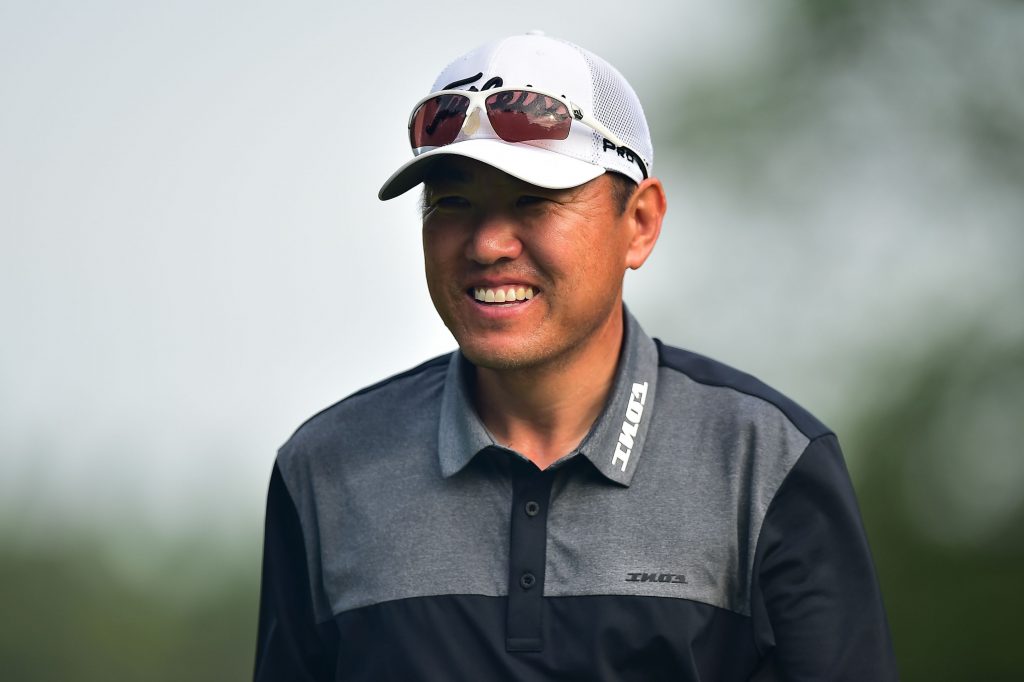
Popular Korean-American golfer Charlie Wi, a seven-time winner on the Asian Tour, came out of semi-retirement to play in Asia earlier this year. He showed few signs of rustiness — finishing in the top-10 in the National Opens of Hong Kong and Malaysia — and fans were looking forward to seeing more of Wi before the world withdrew into lockdown because of the Coronavirus pandemic.
Simon Wilson spoke to him at his home in Los Angeles this week, about how the Tour played such a big part in his career development, about his success on the PGA TOUR and his plans for the Champions Tour, amongst other things.

Charlie Wi of the United States
There was something quite dramatic about Charlie Wi’s first victory as a professional — emerging victorious from the mist to win the Mild Seven Kuala Lumpur Open at the Saujana Golf and Country Club in 1997.
Southeast Asia’s infamous haze had tried its best to cancel the tournament but much to the delight of the young Korean-American golfer — a rookie professional, playing his first season in Asia — they were able to overcome numerous delays, finish the tournament and crown a winner.
“I remember I sang The Gambler by Kenny Rogers on Sunday night after I won!” recalled the genial golfer.
“I actually remember a lot of that tournament. I roomed with John Kernohan (the 1996 Singapore Open champion). I putted really well, and I drove it well. Saujana is really tough but I was able to keep it in play.”
Wi turned professional after graduating from the University of California, Berkeley, in 1995. He played the Nike Tour in 1996 and chose to compete in Asia the following year.
For many decades, aspiring young professionals from the United States have made the journey across the Pacific to learn their trade in the East after graduating college.
Some have succeeded but many have been made to realise that life as a Touring professional is not for them.
Any doubts that Wi would not make the grade were put to rest early on when, at the start of 1997, he finished second at the Qualifying School in Asia. He tied for first with Jim Rutledge before the Canadian defeated him in a play-off — something which did not dent Wi’s confidence too much as Rutledge was rated by his peers as one of the best ball strikers in the game at the time.
Wi’s obvious talent for the game quickly became apparent as he was regularly in contention before his maiden victory in Malaysia suggested something special was about to happen.
Winning by a comfortable margin of four shots at Saujana proved to be the catalyst for Wi’s career.
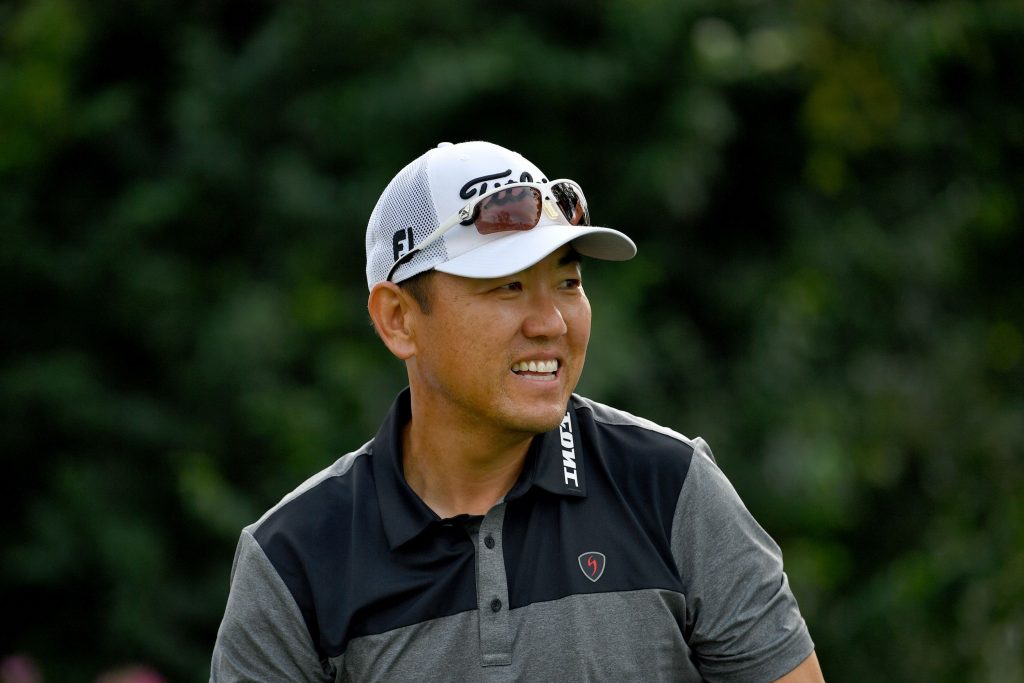
In short, he went on to claim another six other titles on the Asian Tour and two on the Korean Tour before fulfilling his ultimate ambition of playing on the PGA TOUR – where he has earned over an impressive US$10 million.
Wi is always quick to point out that his decision to play in Asia early on was of paramount importance and one that laid the foundations for a career that went beyond his expectations.
“Asia was a great experience. It gave me a great platform to be a professional and to play on the PGA Tour. It allowed me to get to the next level,” said the Korean, whose family left Korea for the US when he was 10.
“I grew as a player playing in Asia. I remember in the fall of 1996 playing in the Hong Kong Open. We were playing on cow grass and I had never played on that before and I wasn’t used to Bermuda grass over in Asia as well. Growing up in California I am used to Poa annua and Bent grass. So the Asian Tour helped me understand different conditions, how the ball flies in certain conditions.
“And, it gave me a place where I could compete all the time as a young professional. To grow as a player you have to compete and compete to win. And when I started winning it totally built my confidence and helped me become a better player.”
Today, the Tour proudly maintains that theme of being a Tour that nurtures young players — its last three Order of Merit champions Gavin Green, Shubhankar Sharma, and Jazz Janewattananond were all under the age of 25 when they won in 2017, 2018 and 2019 respectively. And the average age of the circuit’s membership is also the youngest of any main Tour.
Significantly, playing in Asia also gave Wi his first start on the PGA Tour.
In 2001, one of the finest seasons of his career, he triumphed three times: in the SK Telecom Open and Shinhan Donghae Open, both in Korea, and the Volvo China Open.
The result of his collective efforts was to finish second on the Order of Merit, behind Thailand’s great new golfing hope Thongchai Jaidee.
For Wi, the Volvo China Open stands out and was “probably my most important win” because he earned an invite to the 2002 World Golf Championships-NEC Invitational. He tied for 63rd in his debut appearance on the PGA Tour — merely dipping his elbow in to test the water ahead of returning to play there full-time three-years later.
He had a slightly stalled start on the PGA Tour after making it through their Qualifying School to qualify for the Tour in 2005. He was unable to retain his playing status there that season as he adjusted to life on the elite circuit. However, he quickly regained his Tour card at the school in 2006 and when he returned to the circuit in 2007 it was clear his skill set was able to meet the challenge.
He enjoyed a six-year stretch where everything clicked, finishing second on five occasions and claiming 20 top-10s.“I was pretty consistent all around, if you see my stats, I was top-10, top-15, in all around rankings for all those years,” said Wi.
“My biggest regret, was the chances that I had, I was not able to finish off and win. While you are playing well, everything seems to flow and you don’t think too much about it. It is just a shame I didn’t win and win more than once.”
He said he was close to winning in all of his runner-up finishes but perhaps the 2012 AT&T Pebble Beach National Pro-Am was the one that really got away. He had a three-shot lead after three rounds but American Phil Mickelson shot 64 to beat him by two.
“At that time, the money was so big and I thought even to finish second was great. You don’t think about winning because the rewards are so great. But looking back winning is what really matters, that’s why we practice so hard. I felt like my priorities were a little bit off. I was focusing on finishing high rather than winning.”
He said countryman KJ Choi, a good friend of his, summed it up the best: “To win you need luck, and you didn’t have much luck.”
In 2013, his form started to dip when he went in search of more distance and made swing changes as, “all these kids coming out of college were hitting the ball so far. And I thought if I am going to compete with them, I need to hit it further”.
But although he found more length, he lost one of the hallmarks of his game: accuracy.
“I got myself in trouble. You do things you can to improve but it bit me in the butt!” said Wi.
The trouble might have seen him lose his playing rights in 2014 but not his incredible memories of playing at the “next level”.
He turned 48 in January and having more or less semi-retired for the past few years, Wi is now setting his sights on the Champions Tour in 2022. He will get some starts there thanks to his career earnings but to earn full status, he will need to go to the Champions Tour Qualifying School.
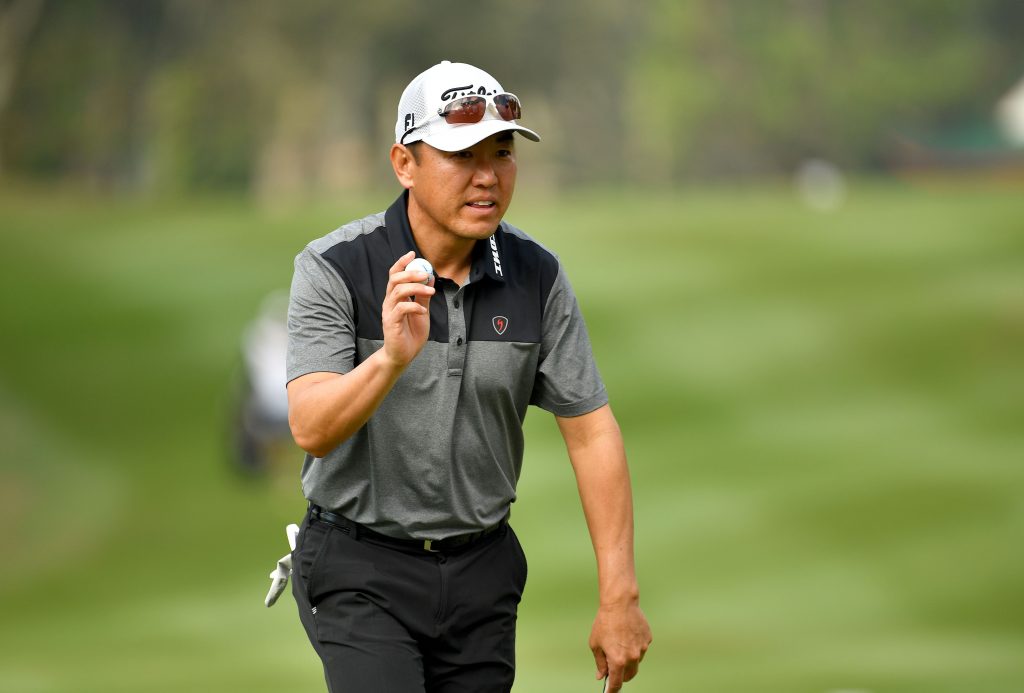
The Korean realised to get ready for that Tour he would need to start competing and that was part of the reason why he returned to Asia.
“It was really great seeing so many old friends, like Dominique Boulet, Unho Park, Anthony Kang and Angelo Que. It was amazing to see them and also watch the new young players,” said Wi.
“Turning 48 made me think this is the time to start playing regularly to stay competitive, to stay physically fit and keep me motivated to practice. As a player it’s really hard to get motivated to practice if you have no events.”
And so having enjoyed watching the young Wi’s career go from strength to strength since that foggy Sunday afternoon in KL, we can now look forward to Master Wi’s foray into the senior game, and of course a return to Asia — when conditions permit.
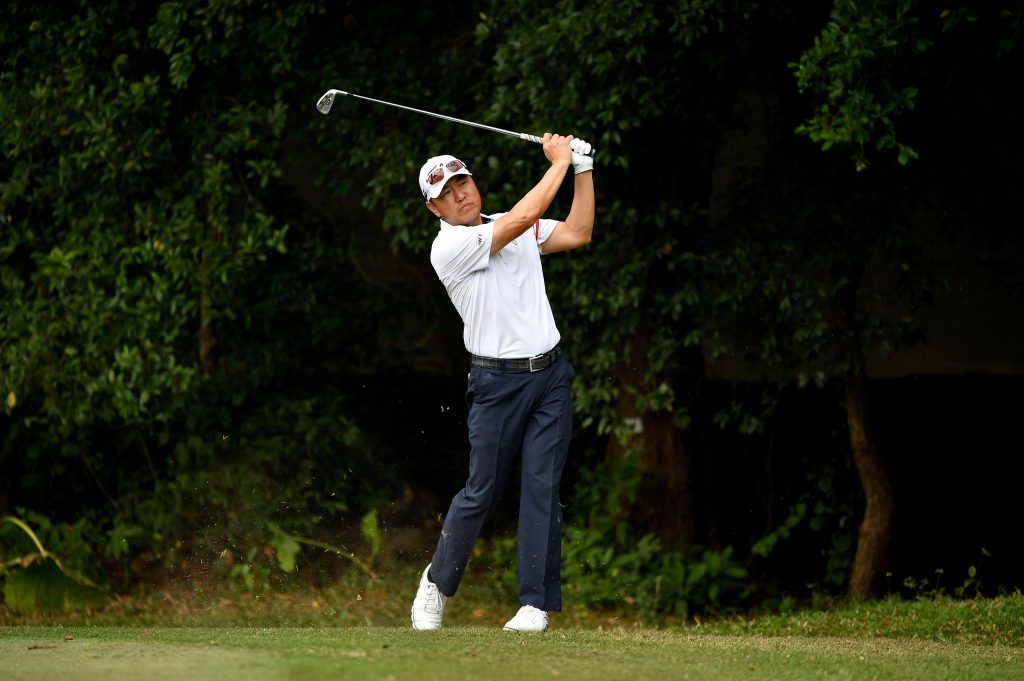

Sentosa, Singapore: May 20: To paraphrase the timeless classic from the Beatles, “Will golf still need me, when I am 64?”
When it comes to Boonchu Ruangkit of Thailand, who celebrated his 64th birthday earlier this month, the answer is emphatically ‘yes’.
Kiradech Aphibarnrat, the only Thai to have secured a full card for the PGA Tour, was among those thanking Boonchu for his guidance over the years on the occasion of his birthday.
On Facebook, Kiradech posted a picture of himself and Boonchu and wished the veteran good luck and good health in the future.
Also, he said that Asian golf was missing a role model like Boonchu on tour.
Make no mistake about it, Boonchu – a proven winner with a lovely, languid swing and an easy manner – was the eminence grise for players of many nationalities, not just Thais.
At tournaments, golfers would gather round him on the practice range, putting green and clubhouse such is his charisma, ability and knowledge of the game and of the vagaries of life.
And, typical of the man, he was always willing to lend an ear, impart words of wisdom and, even, offer a tip or two on putting and chipping, the cornerstones of his game.
Boonchu will always be linked with the Asian Tour, not least because he struck the opening drive when the new player-centric circuit was launched at the Thailand Open in 2004.
Not someone who does things by half, he went on to win his national Open for the second time, an achievement that gives him great joy to this day.
For the record, Boonchu hit the historic first shot at 7.00 am on Thursday, January 22, 2004 with playing partners Thongchai Jaidee, the Thai whose star was just starting to rise internationally, and gifted Korean Kang Wook-soon, looking on at the Royal Thai Air Force Golf Club.
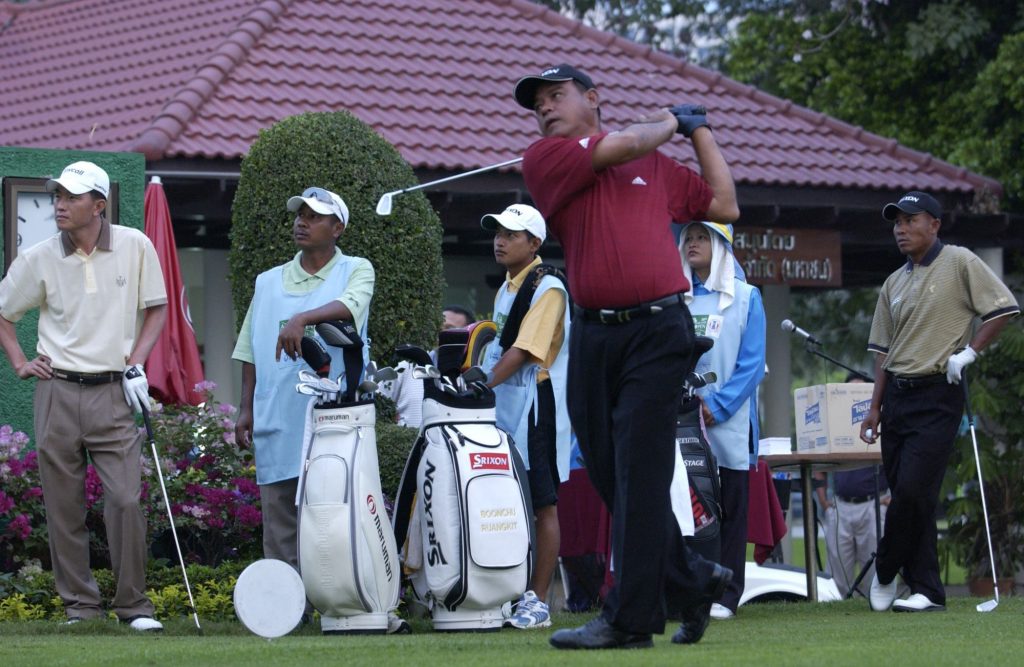
Kang, keen to win the tournament to make up for missing his US PGA Tour card by a stroke at qualifying school the previous month, upstaged Boonchu in the first round by shooting a 63, five shots better than the Thai.
He maintained the lead over the next two rounds and held a one-stroke advantage over fellow Korean Kim Jong-duck heading into the Sunday showdown with Boonchu trailing by three.
That changed quickly with Boonchu opening the final round brightly with birdies at the first two holes and made up for a bogey at the fourth hole with further birdies at the fifth, seventh and 10th holes.
Meanwhile, Kang carded three bogeys and a double bogey in the first nine holes to fall out of contention.
After missing a short par putt at the 17th, Boonchu birdied the last to secure victory by two shots over Kim and Thailand’s Prayad Marksaeng.
“I took the lead at the 10th hole and after that I played cautiously. When I hit my approach shot at the 18th, I knew I had won – it was a great feeling,” said Boonchu, who also won the Thailand Open in 1992, at the time.
“This is the greatest moment of my career. I hit the first drive in 1995 to launch the (former) Tour and hit the first drive this week. It is special to win your home Open and now I have won it twice.”
While Boonchu collected the plaudits and a cheque for US$48,450, a lesser light also recorded an amazing feat that is unlikely to be repeated in world golf.
Chen Chung-cheng of Chinese Taipei shot two aces…at the same hole.
Sadly, he walked away with nothing to show for the incredible double.
The 27-year-old aced the 187-yard fourth hole during the first round and repeated the feat in the third round.
A condominium and a car were on offer at two other par-three holes at the Royal Thai Air Force club but there was no prize for holing in one at the fourth
“No car keys, again,” laughed Chen. “I cannot believe I holed in one at the same hole. When I hit my four iron, I thought it was going to be close but I did not see it go in the hole.
“Tomorrow I will be trying hard to hole-in-one at the eighth (where the condominium was on offer).”
Korean Jun Chul-yoo had better luck than Chen. He was rewarded with a car for his ace at the 13th hole during the second round.
With Boonchu’s remarkable win, a double ace and a feast of low scoring, the tone was set for the new Asian Tour and the circuit has continued to produce the magic that makes top level golf so watchable.
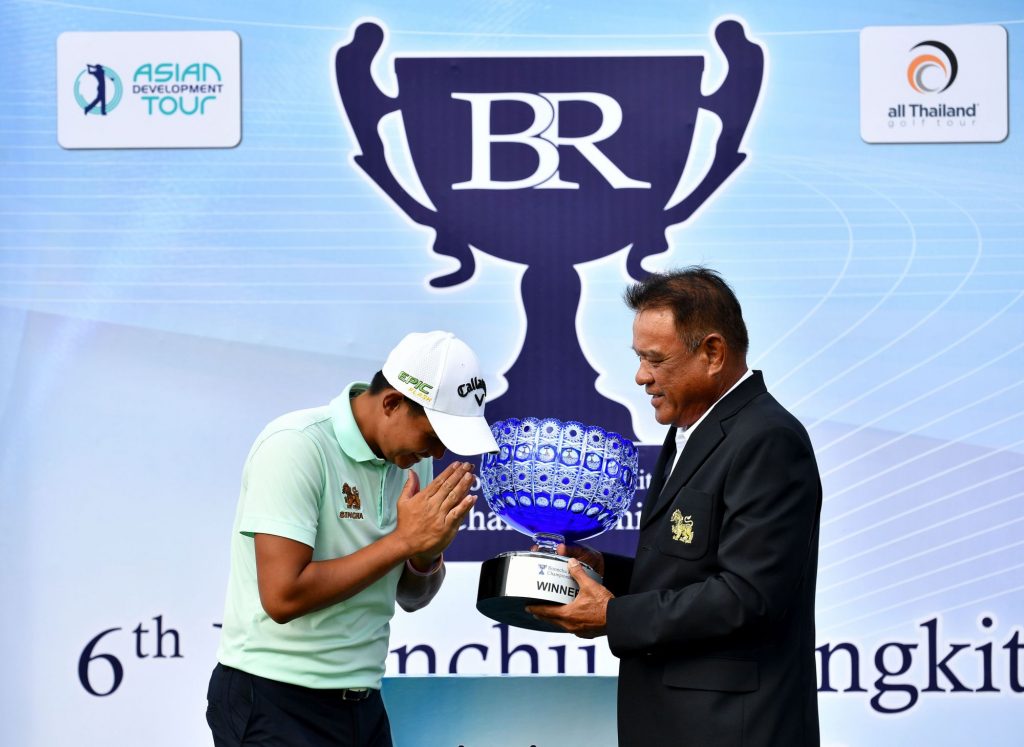
NAKHON RACHASIMA-THAILAND – The Boonchu Ruangkit Championship at the Rancho Charnvee Resort & Country Club, Nakhon Rachasima, Thailand, Sunday January 26, 2020. The approximate USD$ 130.000 event is the 1st event on the 2020 Asian Development Tour. Picture by Paul Lakatos/Asian Development Tour.
Fast forward to more recent times and Boonchu is still having an impact on Asian golf.
He has hosted the Boonchu Ruangkit Championship on the Asian Development Tour since 2015, the most recent of which in January this year attracted a strong field, including Thai stars Thongchai Jaidee and Prayad Marksaeng, and was won by Boonchu’s countryman, the talented Pavit Tangkamolprasert.
Ends.

Here is what the New Zealand Open presented by Sky Sport winner Brad Kennedy had in the bag last week:
Driver: Titleist TS2 9.5* Shaft: Mitsubishi-Chemical Tensei CK Pro Blue 50 S
Fairway1: TaylorMade RBZ Stage 2 15* Shaft: Graphite Design Tour AD MT 7 X
Hb/Ut1: Titleist 818H2 19* Shaft: Graphite Design Tour AD UT 85 X
Hb/Ut2: Titleist 915HD 20.5* Shaft: Graphite Design Tour AD UT 85 X
Irons: Titleist VG3 (5-P) Shaft: Aerotech SteelFiber
Wedge1: Titleist Vokey Design SM8 50*
Wedge2: Titleist Vokey Design SM8 54*
Wedge3: Titleist Vokey Design SM8 60*
Putter: Titleist SC Terryllium TFB 1.5
Ball: Titleist Pro V1 x (2019)
Shoe: FootJoy
Cap: Titleist
Bag: Titleist
Glove: Titleist
Note: No 3-4 Iron
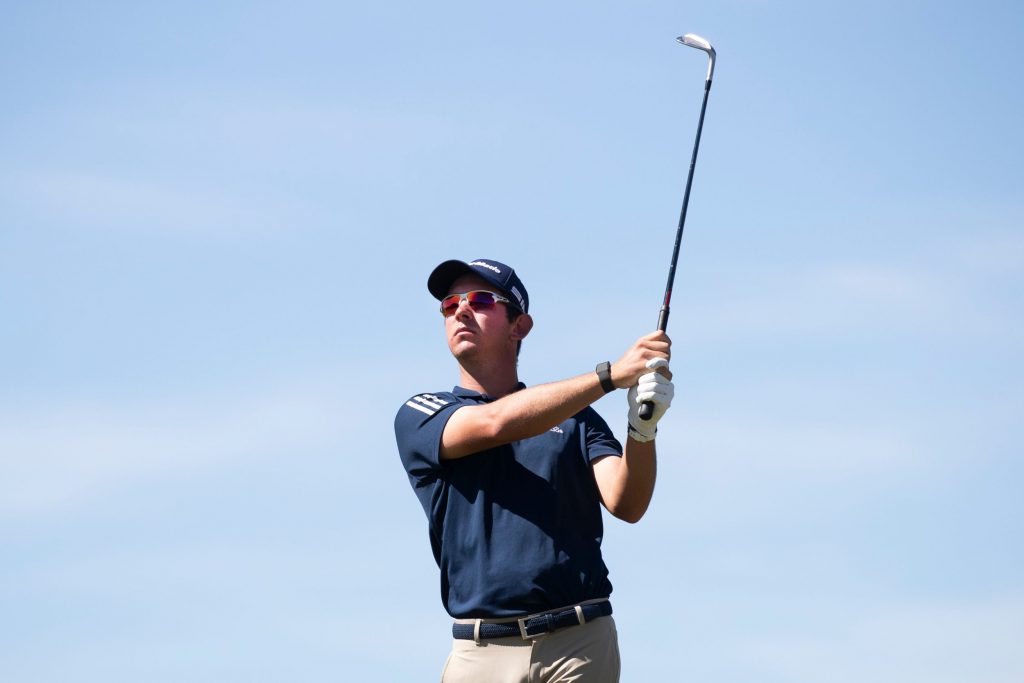
[embedyt] https://www.youtube.com/watch?v=3aMQV7gKPAM[/embedyt]

Hua Hin, Thailand, February 22: Thailand’s Sarit Suwannarut is back for his second straight attempt at the Asian Tour Qualifying School this week. From missing out by a mere one-shot last year to standing at the verge of earning his 2020 Asian Tour card now, it has been a steep learning curve for the 22-year-old Thai.
Sarit, who enjoyed a third-place finish in his first Asian Tour event as a professional in 2018, recounts his early years and talks about why Thongchai Jaidee is highly regarded as his mentor in this blog from Hua Hin.
By Sarit Suwannarut
I grew up in Bangkok and I have lived most of my life in Bangkok. I practice mostly at the Thana City Country Club. They have a Singha Academy where you pay like 100 baht and you can hit as many balls as you want. I also play a lot at the Watermill Golf Club. There are the two places that I usually go to.
When I was a junior, my mom told me to pick between joining the National team and going to college in the United States. I have a friend who is an agent that helps to send Thai kids to college. He gave me a good chance for a full scholarship at the Virginia Tech at that time, so I thought ‘why not take it?’
I played there for only two years though, then and I told my mom I want to come back home and turn professional.
The 2018 Thailand Open was the first Asian Tour event that I played after turning professional and I finished third.
At the Qualifying School last year, I missed out on getting my card by only one shot. It was frustrating for sure. I mean, it’s the first year, and your expectations are high. I want to get on the Asian Tour, I want to play in Europe. But it’s changed. I feel more relaxed coming back to the Qualifying School this year.
To prepare for Q-School this year I just practiced as per normal. I didn’t think the wind was going to be this tough. It was windy as well last year but it’s not this strong. We have to practice a lot of low balls to play well out there, so that’s what I am working on.
The wind hasn’t really been the same every day, you can feel like it’s into the wind when you try to figure it out, but when you hit it, it might be down wind. The wind keeps changing, like every second, so it’s tough.
I’m happy to be in a good spot after three rounds. I will be aiming to finish inside the top-five on Sunday. I mean I’m not thinking about top-35, I still can play bad in the next two rounds but I should aim high and try to catch up with the leader. I think I’m able to do that.
My favourite player is Tiger Woods. Everyone loves Tiger. I look up to him because what he has achieved is incredible. If I have to pick a favourite player from Thailand, I would pick Thongchai Jaidee. I like Thongchai, I’m pretty close to his son and I play with him quite a bit.
Thongchai came from nothing to being one of the best, it just shows how tough a player he is! Thongchai’s a cool guy, he showed me the way he practices and it’s amazing to see how much he has achieved in his career.

Jazz seeks greener pastures after putting lesson with Tiger’s coach
By - ocssoftware
[addtoany]

Jazz Janewattanond hopes a recent golf lesson with Tiger Woods’ putting coach will lift his fortunes as he prepares for the Memorial Tournament presented by Nationwide and World Golf Championships-FedEx St Jude Invitational later this month.
July 10: Thailand’s Jazz Janewattanond hopes a recent golf lesson with Tiger Woods’ putting coach will lift his fortunes as he prepares for the Memorial Tournament presented by Nationwide and World Golf Championships-FedEx St Jude Invitational later this month.
The 24-year-old rising star, who has been in the U.S. since March, was disappointed to miss the halfway cut at the Charles Schwab Challenge and RBC Heritage by one shot and two shots respectively when the PGA TOUR made a welcome return last month following a 91-day hiatus due to Covid-19.
After struggling with a cold putter, where he currently ranks 149th in Strokes Gained: Putting, Jazz sought the advice of Matt Killen, whose star pupils include 82-time PGA TOUR winner Woods and 2017 FedExCup champion, Justin Thomas.
“It would have been nice to play the weekends. I struggled with my putting and lost so many strokes on the greens,” said the Thai, who is ranked 44th in the world on the back of a four-win season on the Asian Tour last year.
Being part of the same management stable as Woods and Thomas has its fringe benefits. When Jazz discussed with his manager his putting woes, Killen’s name was put forward and Jazz flew out to Nashville last week for a three-hour lesson in putting.
“It was a really good three hours spent with Matt. When you see a guy who works with successful players, it gives you the confidence you can trust him. So I’m just following what he’s asking me to do,” said Jazz.
Killen did not tweak Jazz’s putting technique or stroke, especially when the Thai had ranked second for putting average (greens in regulation) on the Asian Tour last season. Instead, the instructor showed Jazz several drills to help him adapt quicker to the intricacies of new greens, considering Jazz will be playing on many golf courses for the first time through his exemptions on the PGA TOUR this year.
“For me, it’s not a technique thing. Matt has taught me how to practice and perceive the putting greens when I get to a tournament site. What we did was to learn how to set up a drill when I get to a new course and work on getting familiarise to the greens,” he said.
With the WGC-FedEx St Jude Invitational being played over four rounds without a 36-hole cut, Jazz hopes to master the putting surfaces at TPC Southwind in Memphis, Tennessee from July 30 to August 2 with the aim of putting up a good result.
“For sure, it’ll be a different mindset for the WGC. You don’t need to worry about the cut and you can have go from the start. You can be more aggressive, which frees your mind up a little bit. I’m glad to be in the field and hope to play well,” said Jazz.
He is also looking forward to meeting golf legend Jack Nicklaus, host of the Memorial Tournament at Muirfield Village, Ohio next week. With Woods confirmed to play at Muirfield where he has won five times previously, Jazz is pumped up.
“I’ve heard a lot of good things about Jack’s place and I’m excited to play there. I’ve read about Jack a lot, obviously the greatest player with 18 major wins. Growing up, it has always been Tiger vs Jack’s record and it’ll be special to be able to meet Jack,” he said.
With the PGA TOUR observing strict protocols under its Health and Safety Plan for tournaments to resume play, Jazz has felt at ease during the first two events. “I have felt safe … it was all good. I also usually eat take-outs so it was fine. There was no issue at all for me.
“Without crowds on site, it does feel a bit different. It’s good we have some volunteers on the course and they are cheering for good shots. We had all the best players for the first two events and it felt like being in a major.”
He is still determined to earn his card on the PGA TOUR through the non-member FedExCup points list. “I won’t give it up. All it takes is one or two good weeks. Who knows what can happen in this game? I’m just going to keep having fun and enjoy myself every time I’m out competing.”
Fans in Thailand will be able to watch the Memorial Tournament and WGC-FedEx St Jude Invitational on Golf Channel Thailand and GOLFTV powered by PGA TOUR.

Australian Scott Hend spoke to Simon Wilson about his rise to become one of the region’s most prolific winners today.
Australian Scott Hend is presently at home in Florida getting ready for the restart of the European Tour and their new ‘UK swing’ later this month. The 10-time Asian Tour winner – who is slated to make his fourth appearance at US Open in September – is raring to go and, during a time of reflection for many, he spoke to Simon Wilson about his rise to become one of the region’s most prolific winners.

SOUTHPORT-ENGLAND – The 146th Open Championship at the Royal Birkdale Golf Club, July 20-23, 2017. Picture by Paul Lakatos/Asian Tour.
When Scott Hend was growing up in Australia and first started to think about making a career out of golf, he says: “I just wanted to play golf for a living. I didn’t think about winning events or how many I could win. I just wanted to play … on golf courses everywhere.”
Perhaps this was just cautious optimism but whatever the strategy he went on to achieve those early ambitions and so much more.
If, back then, he had said: “I want to become one of the most successful players in the history of the Asian Tour, win 10 events there, win on the European Tour and in Australia, play on the PGA Tour, and compete for my country in the Olympics”, well then he would have been a golfing prophet, as all those boxes have also been ticked.
To put it simply, the Australian has been, arguably, the most dominant player on the Asian Tour for the past 13 years and monopolized the Order of Merit list.
In 2016, he became the first Australian to win the Merit title and, impressively, he also finished second on three occasions – in 2013, 2015 and 2019 – and was fourth four times – in 2007, 2009, 2014 and 2017.

Hend was crowned the 2016 Order of Merit champion following the conclusion of Hong Kong Open that year. Picture by Paul Lakatos/Asian Tour.
And when he claimed his 10th Asian Tour title in March 2019 – the Maybank Championship in Malaysia – he moved into second place on the Career Money List.
He is still in second place today with earnings of US$5,084,342 while trailblazing Thai golfer Thongchai Jaidee – a 13-time winner on the Tour – leads the way with winnings of US$5,744,337.
With an innate ability to hit the golf ball prodigious distances, he has harnessed that raw power to devastating effect and beaten some of the best players in the world.
“When I was taught to play golf I was told to hit it as hard as you can,” says Hend, who represented Australia in the 2016 Rio Olympics along with Marcus Fraser.

RIO DE JANEIRO, BRAZIL – AUGUST 08: Scott Hend of Australia in front of the Olympic rings during a practice round at Olympic Golf Course on August 8, 2016 in Rio de Janeiro, Brazil. (Photo by Ross Kinnaird/Getty Images)
“I have been fortunate since I started playing golf to be able to create some decent club-head speed. Not everybody can do that. I am lucky, I have been able to do that and stay relatively injury free. But these days I am more like an average length compared to all the young guys.”
The Australian also had an operation in 2012 to remove an overactive thyroid – which he feels helped his game as it calmed his sometimes fiery persona.
For the moment though, the coronavirus pandemic and its resulting restrictions around the globe have put his playing schedule on hold.
“This is easily the longest break I have had in 26 years,” says the 46-year-old Queenslander.
“It has been okay but it has also been frustrating. Not being able to play tournaments for me has been a very frustrating thing. There is nothing we can do about it. Guys get injured for six or seven weeks but four months feels like forever!”
He was at the Qatar Masters in early March but had to withdraw through an injury and decided to head to Bangkok for treatment.
His wife Leanne and teenage twins Aston and McLaren – yes, he is a lover of fast cars – joined him there on March 20 and it was on that day, when they landed, that Asia basically went into lockdown.
They ended up staying there for two months before being able to buy new tickets to get home to Florida, where he is based since 2003.
He said: “We thought we would just get home as opposed to staying in a friend’s apartment”.

CRANS-MONTANA, SWITZERLAND – SEPTEMBER 10: Scott Hend of Australia lines up a putt as his wife/caddie Leanne Hend looks on at the Omega European Masters at Crans-sur-Sierre Golf Club on September 10, 2017 in Crans-Montana, Switzerland. (Photo by Stuart Franklin/Getty Images)
“Since the European Tour announced they will return for the UK swing I have been back out the last two-and-a-half weeks solidly hitting balls every day trying to get back into it. Hitting golf balls and playing golf are two completely different things. It is going to be interesting when we actually get on the golf course and play,” added Hend.
He plans to fly to the UK on July 17 for a six-week stretch, where his caddie for the past seven years and former Tour professional Tony Carolan will join him.
They will then fly back to America to prepare for what will be his fourth appearance in the US Open – which is being played at Winged Foot Golf Club in New York from September 17-20.
They are returning to the United States two weeks before the tournament just in case they have to quarantine.
The 120th US Open has allocated one spot to the top finisher of the 2019 Asian Tour Order of Merit. With reigning Merit champion Jazz Janewattananond already exempt through his Official World Golf Ranking in March, second-placed Hend will take the coveted spot in the prestigious event where he made his Major debut in 2004.
“It is going to be pretty cool. The last time I played Winged Foot was in the 2006 US Open and Geoff Ogilvy won, I finished T32,” he said.

MAMARONECK, NY – JUNE 17: Scott Hend of Australia hits a shot as his caddie Ray Farnell looks on during the third round of the 2006 US Open Championship at Winged Foot Golf Club on June 17, 2006 in Mamaroneck, New York. (Photo by Jamie Squire/Getty Images)
Exactly when he will be able to return and play on the Asian Tour will be determined over the coming months, when the situation here becomes clearer.
His time spent in Asia has brought rich rewards, instilled a belief in his game and been at the heart of his success as a Tour professional.
Early on in his career, he played on the Canadian Tour for many years – winning the Victoria Open in 2002 – before deciding play on the PGA Tour in 2004, which was when he bought a house in Florida and as he says: “set up shop there”.
But after two seasons, injuries (wrist) and playing poorly saw him lose his playing rights and he turned his attention to the Far East and the Asian Tour Qualifying School in 2006.
“I finished second to Ben Leong (at the Qualifying School). My kids were born in December 2006 and then I went straight to Pakistan and finished second and from there on it was ‘happy days’ on the Asian Tour,” says Hend.
His first win came in 2008 at the Pertamina Indonesia Presidents Invitational while his most recent was the 2019 Maybank Championship.
He enjoyed a bumper year in 2013 claiming three titles: in the Chiangmai Golf Classic, the Mercuries Taiwan Masters, and the Macau Open.

HUA HIN – THAILAND – Scott Hend of Australia is sprayed with champagne on the 18th green on Sunday March 13, 2016 during the final round of the True Thailand Classic presented by Chang at Black Mountain Golf Club, Hua Hin, Thailand. A USD$ 1.75 million event co-sanctioned with the European and Asian Tour. Picture by Paul Lakatos/Asian Tour.
But he rates his win in the Hong Kong Open in 2014 as his finest as it was jointly-sanctioned with the European Tour and allowed him to earn his card there for the first time. He is also extremely proud to have won an event steeped in history, boasting so many great Australians as past champions.
“I have a lot of friends in Asia, I like the people, I like the food, and the golf courses are quite similar to where I grew up in Australia. The grasses are very similar. It is not like I am in a strange world. Australia is very close to Asia so it is very similar,” says Hend.
The Australian came so close to winning the Omega European Masters in 2016 and 2017 but lost both times in sudden-death play-off, to Swede Alex Noren and then Matthew Fitzpatrick from England.
“The first one wasn’t that bad because Alex holed a fantastic putt to win but that second one took a lot longer for me to get over because I hit a putt where I thought I should have but I just mis-read it. The second loss was extremely disappointing. It took a fair while to get over that and to start playing good golf again.
“I don’t normally let these things bother me but for some reason that one did. I guess because it was two years in a row and I really, really wanted to win there as I love the place and I really want to win on European soil. The second one was a bit more telling with a bit of a sting in the tail.”
But Hend, having been a professional since 1997, been a member of at least five Tours and won 15 tournaments around the world, has experience in abundance and is philosophical about his career.
He says: “This is the profession we are in, it’s quite volatile, there are lot of guys around the world every year trying to get to a certain place there are only a certain amount of spots and you have to be a realist about it. That’s the way it goes, sometimes you can’t get what you want. Then you just have to work hard and you find other ways to make a living and other Tours to play.
“I am very lucky, I am very fortunate to be able to do this. I get to travel all year and see things, so in that regard my job is quite special. I feel very lucky to be good enough at it to do that.”

Burmese veteran Zaw Moe talks to Simon Wilson about the many highlights of his distinguished career.
Zaw Moe, the Myanmar golfer who has made Singapore his home for nearly 30 years, turned 53 at the weekend. Simon Wilson caught up with the Asian and Japan Tour veteran to discuss the many highlights of his distinguished career.

When Zaw Moe launched one of his long, trademark drives – just over 290 yards – on Thai Country Club’s 17th hole in the Asian Honda Classic, in February 1997, it brought rapturous applause from the huge gallery assembled there.
It was the kind of moment the young-man from Myanmar lived for, but this was a particularly exceptional occasion: it was the final round, the final pairing and, thrust into the global spotlight, he was playing with a rookie professional who was to shape the game of golf like no other: Tiger Woods.
The American, aged just 21, was playing in Thailand for the first time as a professional and having already claimed three PGA Tour titles, he arrived with much expectation, fanfare and at times uncontrollable excitement.
During an unprecedented week – the likes of which had never before been seen in Asia – Woods dominated from start to finish: he had a six-shot lead at the start of the day and won by 10! It proved to be a warning shot to the world as two months later he claimed the first of his five US Masters titles by 12 strokes!
However, on that penultimate hole at Thai Country Club just outside Bangkok, Woods did make a rare mistake when he pushed his tee shot into water on the right.
“I could see he was angry,” recalls Zaw.
“He told ‘Fluff’ (Mike Cowan) his caddie to give him another ball as he wanted to hit from the tee as opposed to taking a drop. He then drove 30 yards past me. Then, I hit five wood for my second to the green but he hit six iron.
“And on 18 I hit another great tee shot but he hit a two-iron as far as my driver. He was on a different level and I realized I was just a spectator as the round went on.”
With wildly enthusiastic crowds all around him, Zaw did well to record a top-20 finish.
While the result was not what he was looking for, it was another giant moment in the career of Zaw.
The tall golfer with a much-admired, silky-smooth swing is one of his nation’s finest sporting exports who boasts an outstanding record on both the Asian Tour and Japan Golf Tour Organization – he played on the latter circuit with great success for nearly 10 years starting from 1996.
He has claimed 21 titles in the region including the 1997 Singapore Open at Jurong Country Club and early on in his career, he dominated the local Malaysian circuit claiming three Order of Merit titles.

Zaw Moe lifting the Singapore Open trophy in 1997.
Moe is part of the “Great Triumvirate” of pioneering golfers from Myanmar, along with Mya Aye and Kyi Hla Han.
Mya Aye was the first to make a mark for Myanmar in the 1970s and won six times in the region.
And Han, the country’s greatest golfer, followed not long after – finding a home for many of the region’s most prestigious trophies and becoming Asian Tour Order of Merit champion in 1999.
All three are also past winners of the Singapore Open: Mya Aye claimed the title in 1981 and Han in 1994.

Zaw Moe with fellow countryman Kyi Hla Han (left).
It is one of the Asian Tour’s most appealing and enduring qualities that, through its diversity, it has facilitated the emergence of elite players from countries that, perhaps, you would least expect.
Myanmar is one such nation that few would expect to contribute to Asia’s golfing landscape, but it most certainly has done and continues to do so.
Zaw turned professional in 1989 and it didn’t take long for him to find his feet in the game, despite facing the daunting prospect of heading on the road as a Touring professional, aged just 22, and with very limited resources.
“When I turned professional and first came out of Myanmar I only had US$700 in my pocket, plus one golf set and a suitcase,” said Zaw, who was born in Lashio – in Myanmar’s Shan State, where his father was the Chief Engineer.
“I was heading to stay with Chan Han (Kyi Hla Han’s brother) in Malaysia but could not get a visa so I had to stay in Bangkok for a month – where I spent US$200, so I was down to US$500.
“When I eventually got to Malaysia – where I planned to play on the domestic Malaysian circuit – I won about MYR1,300 in my first event in the Cameron Highlands. This was in December, 1989. Then, in my second event I finished third so I won about MYR1,700 and in my third event I lost in playoff so I won about MYR3,000. This was the ‘kick start’ to my career.”
With his confidence fortified by success in Malaysia he then chose to try his hand on the Asian Tour – which at that time was run by the Asia Pacific Golf Confederation and local Golf Associations.
It was in the days before they had a Qualifying School and formal Tour membership, so players had to enter Monday qualifying rounds.
Said Zaw: “I spent all my money and went back to Malaysia to stay with Chan and make money on the Malaysian circuit again.”
Zaw won dozens of events on the TDC Tour of Malaysia and it wasn’t long before his game was at the level required to compete regularly on the Asian Tour.
Initially, he lived in Penang before his sponsor, Pan-West, kindly helped him set up in Singapore – where he has been living since the early 90s.
And it was there where he soon recorded the biggest victory of his career.
“Since 1995 I had been playing well but I couldn’t win, so when I arrived at the Singapore Open I felt I was due,” said Zaw.
At the start of the final round, he was four in front of an imposing chasing pack that included Thailand’s Boonchu Ruangkit. But he prevailed comfortably finishing the tournament on 11 under, after rounds of 67, 69, 69 and 72, to win by three from American Fran Quinn and earn a cheque for US$80,750.

Zaw Moe with Thai legend Boonchu Ruangkit (left).
Many more victories were expected to follow but, remarkably, Moe lost in seven play-offs during his career: three on the Asian Tour and four in Japan.
“If I go and play now, I think I would win more. I was trying to be too perfect back then. I would have won more tournaments if I had just accepted myself. I was looking for the one perfect swing,” said Zaw.
“I was very technical. I was looking for the perfect swing and this was one of the biggest mistakes in my life. Everyone, like Mardan (Mamat), told me, God gave you a good swing, why did you go and change it? At the end of the day you have to rely on your old swing and keep the basics. That’s all you have to do.”
His quest for excellence saw him regularly travel to the United States to see the best coaches in the world, including: Butch Harmon, David Leadbetter, Robert Baker and Phil Ritson.
Zaw acknowledges that his penchant for perfection is more of an attribute these days as much of his time is spent teaching at Singapore Island Country Club.
“It’s actually a good thing now because I can pass all my experience on to my students,” said Zaw, who also coached the Myanmar national team in 2011.

As well as a case of analysis paralysis Moe has also had more than a fair share of injuries.
He slipped a disc playing in the Johnnie Walker Classic in Thailand in 2003, which required an operation.
“After that my game went down in 2005. I stopped moving my body and was just swinging my hands and arms which is no good. And I lost it all,” he said.
And, in 2007, he had a liver infection – relating to a bout of Hepatitis C he got when growing up in Myanmar – which put him out of action for 13 months.
In 2015, he damaged his right wrist severely playing out of the rough at an Asian Tour event in Chiang Mai. He had to rest for six months, and that’s when he got more involved in teaching.
And much more recently, he fell over while jogging in Bishan Park in 2018 and broke his left knee and right wrist. He had just earned his Tour card for the Japan Seniors Tour and was due to fly out.
“When I fell over I also passed out but luckily a passer-by helped me back on to my feet so I was able to get home. I could have played 20 events that year,” he said.
He was also due to play in Japan this year but the coronavirus pandemic put pay to that.
Zaw’s wife Yukiko is Japanese but he has not been able to see her for months as she was in Japan when lockdown took effect.
He has been spending his time getting fit and losing weight in preparation for when he can play tournaments again and he has a busy teaching schedule.
Over the years, one of his students has been Cho Minn Thant – the Asian Tour Commissioner and CEO.
Zaw knows Cho, who grew up in Canberra but is from Myanmar, very well as he has been coaching him since he was 15 years old.
“Actually, he can play. But he didn’t play enough. He had the game but he never went out and tried it. So he didn’t know what his potential was. He hits the ball so long these days,” said Zaw.
Zaw certainly made the leap of faith, never looked back and earned his place as one of the legends of Asian golf.

The Sentosa Golf Club is an Asian Tour destination that always strives to place itself at the forefront of the golf industry as Simon Wilson investigates. It is hard to believe it has been 15 years since Singapore’s iconic National Open was first played on the hallowed turf of The Serapong at Sentosa Golf Club. In […]
It is hard to believe it has been 15 years since Singapore’s iconic National Open was first played on the hallowed turf of The Serapong at Sentosa Golf Club.
In that time, Sentosa Golf Club’s standing in the game globally has grown exponentially —buoyed by hosting other world-class events and being the recipient of countless awards.
This year, the majestic layout was due to undergo renovation work — allowing it to maintain its undoubted lead over its competitors.
But just as work started, everything came to a grinding halt in April when the nation was thrust into lockdown because of the Coronavirus Pandemic.
This, however, failed to affect the enthusiasm and energy of Andy Johnston — the General Manager and Director of Agronomy at Sentosa Golf Club — and the mastermind behind the successful growth and development of The Serapong and the venue’s second layout, The New Tanjong.
If anything, the pause in proceedings has steeled Johnston’s determination to make Serapong even greater.
“It’s going to be spectacular!” says Johnston, about plans for The Serapong when work restarts.
“As we know, this year has seen unprecedented circumstances that none of us could have predicted. We’re in the midst of a global pandemic where there are much bigger issues at play, and the health and safety of the world’s population is the number one priority.
“This has been our attitude when it has come to the renovations – if there’s a slight delay, so be it, however we must, and have, take the safety of our workforce, members, guests and the population of Singapore very seriously. Every industry and sector across the world has taken a hit with this situation and golf is no different.”

Andy Johnston, General Manager and Director of Agronomy at Sentosa Golf Club. Picture by Paul Lakatos/Lagardere Sports.
The upgrade of The Serapong was due to be a “three-month tactically planned operation”, which although delayed for the moment will quickly resume once the green light is given.
The operation, advanced and technical in true Sentosa fashion, is one that will further cement the course’s position in Golf Digest’s ‘Top 100 Greatest Golf Courses’ rankings — which moved up 20 places last year to reach 59th. The Serapong and The New Tanjong are also ranked first and second respectively on Golf Digest’s ‘Best Golf Courses in Singapore’ rankings.
The greens, famous for their speed and expanse, will undergo deep soil modifications with a drill and fill programme; this means the historic playing surfaces will not be disturbed.
This programme will see them drill large one-inch holes in the greens, 12 inches deep — a dynamic process to update the soil profile. Two special drill and fill machines were purchased from America last year and shipped over for the assignment.
Says Johnston: “This process will allow us to update and re-engineer the soil profile without removing the grass. The benefit will be a stronger, healthier surface that should be able to handle higher degrees of stress. And we all know what that means: harder, faster surfaces.”
In addition, all the grass on the fairways, and the bunker and green surrounds will be removed and replaced with new, clean Zoysia. Platinum Paspalum will be used for the new tees.
The areas will also be regraded, which includes the tees being re-lasered flat and widened back out into their original size, pointing down the fairway.
In addition, all bunker faces and shapes will be regraded and the bunkers will be replaced with new sand.
Johnston’s mission will be helped by the fact that he was in charge the last time the layout was remodelled in 2006. The course, designed by Ronald Fream and opened in 1982, underwent a S$12 million revamp, and reopened in time for Australian superstar Adam Scott to win the second of his three Singapore Open titles.
At the time Johnston was part of the Bates Golf Design team — who had been engaged to handle the project — but the American returned to the club on a full-time basis in 2010 as Director of Agronomy before becoming General Manager in 2013.
In 2019, the club enjoyed a celebrated year in terms of awards and when the latest remodeling is completed, there is no doubt more honours await.
The club was chosen as the ‘World’s Best Golf Club’ at The World Golf Awards at a special ceremony in Dubai; voted by the players on the Asian Tour as the ‘Best Golf Course on Tour’; gained a position in Platinum Clubs’ ‘World Top 100’; won the Golf Inc. ‘Environmental Stewardship Award of the Year’; and also achieved further success at The Asian Golf Awards winning the ‘Best Managed’, ‘Best Maintained’, ‘Best Food and Beverage’ and ‘Best Championship Course in Asia’ titles to claim their Grand Slam of awards.
The Asian Tour players also voted the SMBC Singapore Open the ‘Best Event on Tour’ for the second time in its history, following 2017.
The Awards — and the fact the club is home to the Asian Tour and the R&A, in Asia, headquarters — makes Johnston and his team feel “incredibly privileged”.
Says Johnston: “We are very proud of the team and our accomplishments, particularly in the last 12 months. When reviewing all of the awards and accolades that have come in during that time, there are many we can be very proud about.”
Perhaps one of the greatest accolades came earlier this year when American Matt Kuchar won the SMBC Singapore Open in January. The world’s leading players regularly praise the golf club and its facilities but “Kuch” was positively ecstatic about The Serapong saying the greens were some of “the best I have played on”.
“Not only were we proud to crown Matt Singapore Open Champion, but his vote of confidence was reassuring to us as we feel we belong amongst the world’s best and we are very proud to host the prestigious Asian Tour event. That host venue status is an honour in its own right,” added Johnston.

SINGAPORE- Matt Kuchar of the USA pictured with the winner’s trophy on Sunday January 19,2020, during the final round of the SMBC Singapore Open at the Sentosa Golf Club, Singapore. The USD$ 1 million event is co- sanctioned with the Asian Tour and Japan Tour, January 16-19, 2020. Picture by Paul Lakatos/Lagardére Sports.
Of course work will proceed with pace on all areas at the club once conditions permit and Johnston is quick to point out that their sustainability and #Keepitgreen campaign are a priority.
They are investing in biodigesters for both food and horticultural waste. The biodigesters will help convert the waste to plant food, which will then be spread back out onto the golf courses as fertiliser. And they also have ambitious plans to install a floating solar farm in the lagoon, implement electric car charging stations and they are currently working to join Group on Earth Observations (GEO) and become certified.
Says Johnston: “So, there’s lots more to come and plenty to be excited about when it comes to our green agenda. The sky is the limit really!”
He feels “that while it has been a real honour to have captured all of the accolades, in some ways it has become bigger than just Sentosa Golf Club or the golf course, as we are now representing the world of golf and our wonderful city.”
And while the world awaits to resume in the “new normal”, the American is prepared and looking forward to the challenges ahead.
“My role as General Manager and Director of Agronomy has not changed,” he says.
“The tremendous responsibility to take care of a property like this, and now even challenged more than ever with a reduced team, to use my time-earned intuitive skill to help stay ahead of what Mother Nature might send our way is a mission that is always never ending, and one I relish each and every day, when I am able to go to work every day to review and check on the grass and property. We just hope this all ends safely.”

On reaching the age of 50, which Korean icon K.J. Choi did last month (May 19), it is usual to take stock and reflect on your life achievements. For Choi, one of the region’s golf greats and an honorary member of the Asian Tour, his performance statistics and the good deeds done by his Foundation […]
On reaching the age of 50, which Korean icon K.J. Choi did last month (May 19), it is usual to take stock and reflect on your life achievements.
For Choi, one of the region’s golf greats and an honorary member of the Asian Tour, his performance statistics and the good deeds done by his Foundation tell the story of a dedicated professional and a committed humanitarian who has met his goals both on and off the course.
A quirk of fate that saw him switch from powerlifting to golf aged 16, a dog-eared copy of Jack Nicklaus’ instructional classic “Golf My Way”, a solitary golf club and an admirable work ethic combined to kick-start his glorious career.
Choi taught himself the game by leafing religiously through the pages of “Golf My Way” and putting into practice what the ‘Golden Bear’ preached. It was a slog on a course two hours by bus from his home with day-long sessions that stretched into months and years, culminating in Choi turning professional in 1994 aged 24.

YEOJU-GUN, SOUTH KOREA – OCTOBER 23: K J Choi of Korea punches the air after a birdie on the 16th green during round four of the CJ Invitational at Haesley Nine Bridges Golf Club on October 23, 2011 in Yeoju-gun, South Korea. Photo by Paul Lakatos/Asian Tour.
He cut his competitive teeth on the Korean, Asian and Japan Tours. His won the 1996 Korean Open and after expanding his horizons beyond the Korean Tour won three times in 1999 – the Kirin Open and Ube Kosan Open (Japan Tour) and the Korean Open (Asian Tour), for a second time.
Choi became the first Korean to earn a card for the PGA Tour, via Q-School in 1999. Strikingly, Choi has played 468 tournaments on the circuit, won eight times, made 330 cuts and earned more than US$32.5 million.
Having hit his targets time and time again on the links, Choi has set himself a loftier challenge in society at large – ‘it is my life goal to help the children around me,’ he says.
To that end, his Foundation gives scholarships to less fortunate students to ensure they receive a college education.
Choi had planned to split his playing time between the PGA Tour and the Champions Tour from his base in the United States this year before the season was thrown into turmoil.
But Choi has not forgotten his roots and the opportunities afforded him by the Asian Tour as he improved his game to a level that marked him down as the ‘Asian player most likely to win a Major.’
On his frequent return visits to Asia, he has won several times including the Iskandar Johor Open in 2009 and the CJ Invitational in Korea back-to-back in 2011 and 2012.
Choi credits his time on the Asian Tour as the perfect proving ground for the PGA Tour.
“(My success) on the PGA Tour really stems from the years starting out in Korea, making my way gradually out into bigger arenas starting with the Asian Tour,” he said in a past interview.
“Definitely days competing on the Asian Tour really helped me a lot, I learned everywhere I went. All the tournaments I played I learned a lot and that was the foundation of my success (on the PGA Tour).”

PEBBLE BEACH, CALIFORNIA – FEBRUARY 06: K.J. Choi of Korea plays his shot from the third tee during the during the first round of the AT&T Pebble Beach Pro-Am at Monterey Peninsula Country Club on February 06, 2020 in Pebble Beach, California. (Photo by Chris Trotman/Getty Images)
A goal-setter, Choi adopted the mantra of “to be the best, you’ve got to play with the best” and mapped out a path which he hoped one day would result in him winning a Major.
He felt his best chance was probably the Masters and practiced hard to perfect the shots he felt were required around Augusta.
His dedication nearly paid huge dividends with three top-10 finishes at the Masters (his best finish coming in 2004 when he was third) and six overall in Majors.
That countryman Y.E. Yang took the honours as first Asian to win a Major, by pipping Tiger Woods at the US PGA Championship in 2009, detracts little from the huge enjoyment and sense of pride Choi gave to Asian golf fans throughout his career.
His success is even the more remarkable given that as a teenager Choi, a promising powerlifter, did not have the vaguest notion about the ancient game of golf.
The tale of how he came to learn about the sport and the lengths he took in honing his game is both inspiring and revealing.
His official biography on kjchoi.net tells it best.
“Choi was born as the oldest son with two younger brothers and one younger sister. Both of K.J.’s parents were farmers on a small island called Wando, in the southernmost part of Korea.
“While attending his local high school, K.J. joined the powerlifting team. When K.J. was only 13 years old he could squat 350 pounds (approximately 159 kilograms), a feat for which he was later given the nickname ‘Tank’ by fellow South Koreans.
“One day when K.J. was 16, the powerlifting coach told the team to separate into two lines. One line would continue to practice powerlifting, and the other would begin to practice a sport called golf. Nobody in that golf line knew what golf was, including K.J., so he slyly left the golf line, thinking he had outsmarted his destiny and went back into the powerlifting line.
“Luckily the coach saw him change lines and demanded that he play golf. The coach gave K.J. a single golf club and a book written by Jack Nicklaus called ‘Golf My Way’. From that day on, ‘Golf My Way’ became K.J.’s holy grail, and he taught himself how to play golf.
“K.J. lived more than two hours from the nearest golf course, so he would wake up at 5 a.m. every morning and take the bus to the golf course and practice. K.J. would practice religiously until it got dark.
“Most of the people in K.J.’s community didn’t know what golf was and tried to convince his parents to make K.J. quit. People thought K.J. was wasting his time, yet after six years of practice and two years serving in the military, K.J. became a professional golfer.”
The rest, as they say, is golfing history.
Since turning 50 last month, K.J. Choi has experienced two big moments in his family life.
His daughter Amanda, 18, had a drive-in graduation ceremony from Westlake Academy in Texas and his 23-year-old son David joined the Republic of Korea Marine Corps for his military service.
Choi said of his daughter: “We are so excited to see her proceed through life with passion and courage.”
And as his son left for Korea Republic, Choi commented: “David, you will always be in my heart. Miss you.”

Popular Korean-American golfer Charlie Wi, a seven-time winner on the Asian Tour, came out of semi-retirement to play in Asia earlier this year. He showed few signs of rustiness — finishing in the top-10 in the National Opens of Hong Kong and Malaysia — and fans were looking forward to seeing more of Wi before […]
Popular Korean-American golfer Charlie Wi, a seven-time winner on the Asian Tour, came out of semi-retirement to play in Asia earlier this year. He showed few signs of rustiness — finishing in the top-10 in the National Opens of Hong Kong and Malaysia — and fans were looking forward to seeing more of Wi before the world withdrew into lockdown because of the Coronavirus pandemic.
Simon Wilson spoke to him at his home in Los Angeles this week, about how the Tour played such a big part in his career development, about his success on the PGA TOUR and his plans for the Champions Tour, amongst other things.

Charlie Wi of the United States
There was something quite dramatic about Charlie Wi’s first victory as a professional — emerging victorious from the mist to win the Mild Seven Kuala Lumpur Open at the Saujana Golf and Country Club in 1997.
Southeast Asia’s infamous haze had tried its best to cancel the tournament but much to the delight of the young Korean-American golfer — a rookie professional, playing his first season in Asia — they were able to overcome numerous delays, finish the tournament and crown a winner.
“I remember I sang The Gambler by Kenny Rogers on Sunday night after I won!” recalled the genial golfer.
“I actually remember a lot of that tournament. I roomed with John Kernohan (the 1996 Singapore Open champion). I putted really well, and I drove it well. Saujana is really tough but I was able to keep it in play.”
Wi turned professional after graduating from the University of California, Berkeley, in 1995. He played the Nike Tour in 1996 and chose to compete in Asia the following year.
For many decades, aspiring young professionals from the United States have made the journey across the Pacific to learn their trade in the East after graduating college.
Some have succeeded but many have been made to realise that life as a Touring professional is not for them.
Any doubts that Wi would not make the grade were put to rest early on when, at the start of 1997, he finished second at the Qualifying School in Asia. He tied for first with Jim Rutledge before the Canadian defeated him in a play-off — something which did not dent Wi’s confidence too much as Rutledge was rated by his peers as one of the best ball strikers in the game at the time.
Wi’s obvious talent for the game quickly became apparent as he was regularly in contention before his maiden victory in Malaysia suggested something special was about to happen.
Winning by a comfortable margin of four shots at Saujana proved to be the catalyst for Wi’s career.

In short, he went on to claim another six other titles on the Asian Tour and two on the Korean Tour before fulfilling his ultimate ambition of playing on the PGA TOUR – where he has earned over an impressive US$10 million.
Wi is always quick to point out that his decision to play in Asia early on was of paramount importance and one that laid the foundations for a career that went beyond his expectations.
“Asia was a great experience. It gave me a great platform to be a professional and to play on the PGA Tour. It allowed me to get to the next level,” said the Korean, whose family left Korea for the US when he was 10.
“I grew as a player playing in Asia. I remember in the fall of 1996 playing in the Hong Kong Open. We were playing on cow grass and I had never played on that before and I wasn’t used to Bermuda grass over in Asia as well. Growing up in California I am used to Poa annua and Bent grass. So the Asian Tour helped me understand different conditions, how the ball flies in certain conditions.
“And, it gave me a place where I could compete all the time as a young professional. To grow as a player you have to compete and compete to win. And when I started winning it totally built my confidence and helped me become a better player.”
Today, the Tour proudly maintains that theme of being a Tour that nurtures young players — its last three Order of Merit champions Gavin Green, Shubhankar Sharma, and Jazz Janewattananond were all under the age of 25 when they won in 2017, 2018 and 2019 respectively. And the average age of the circuit’s membership is also the youngest of any main Tour.
Significantly, playing in Asia also gave Wi his first start on the PGA Tour.
In 2001, one of the finest seasons of his career, he triumphed three times: in the SK Telecom Open and Shinhan Donghae Open, both in Korea, and the Volvo China Open.
The result of his collective efforts was to finish second on the Order of Merit, behind Thailand’s great new golfing hope Thongchai Jaidee.
For Wi, the Volvo China Open stands out and was “probably my most important win” because he earned an invite to the 2002 World Golf Championships-NEC Invitational. He tied for 63rd in his debut appearance on the PGA Tour — merely dipping his elbow in to test the water ahead of returning to play there full-time three-years later.
He had a slightly stalled start on the PGA Tour after making it through their Qualifying School to qualify for the Tour in 2005. He was unable to retain his playing status there that season as he adjusted to life on the elite circuit. However, he quickly regained his Tour card at the school in 2006 and when he returned to the circuit in 2007 it was clear his skill set was able to meet the challenge.
He enjoyed a six-year stretch where everything clicked, finishing second on five occasions and claiming 20 top-10s.“I was pretty consistent all around, if you see my stats, I was top-10, top-15, in all around rankings for all those years,” said Wi.
“My biggest regret, was the chances that I had, I was not able to finish off and win. While you are playing well, everything seems to flow and you don’t think too much about it. It is just a shame I didn’t win and win more than once.”
He said he was close to winning in all of his runner-up finishes but perhaps the 2012 AT&T Pebble Beach National Pro-Am was the one that really got away. He had a three-shot lead after three rounds but American Phil Mickelson shot 64 to beat him by two.
“At that time, the money was so big and I thought even to finish second was great. You don’t think about winning because the rewards are so great. But looking back winning is what really matters, that’s why we practice so hard. I felt like my priorities were a little bit off. I was focusing on finishing high rather than winning.”
He said countryman KJ Choi, a good friend of his, summed it up the best: “To win you need luck, and you didn’t have much luck.”
In 2013, his form started to dip when he went in search of more distance and made swing changes as, “all these kids coming out of college were hitting the ball so far. And I thought if I am going to compete with them, I need to hit it further”.
But although he found more length, he lost one of the hallmarks of his game: accuracy.
“I got myself in trouble. You do things you can to improve but it bit me in the butt!” said Wi.
The trouble might have seen him lose his playing rights in 2014 but not his incredible memories of playing at the “next level”.
He turned 48 in January and having more or less semi-retired for the past few years, Wi is now setting his sights on the Champions Tour in 2022. He will get some starts there thanks to his career earnings but to earn full status, he will need to go to the Champions Tour Qualifying School.

The Korean realised to get ready for that Tour he would need to start competing and that was part of the reason why he returned to Asia.
“It was really great seeing so many old friends, like Dominique Boulet, Unho Park, Anthony Kang and Angelo Que. It was amazing to see them and also watch the new young players,” said Wi.
“Turning 48 made me think this is the time to start playing regularly to stay competitive, to stay physically fit and keep me motivated to practice. As a player it’s really hard to get motivated to practice if you have no events.”
And so having enjoyed watching the young Wi’s career go from strength to strength since that foggy Sunday afternoon in KL, we can now look forward to Master Wi’s foray into the senior game, and of course a return to Asia — when conditions permit.


Sentosa, Singapore: May 20: To paraphrase the timeless classic from the Beatles, “Will golf still need me, when I am 64?” When it comes to Boonchu Ruangkit of Thailand, who celebrated his 64th birthday earlier this month, the answer is emphatically ‘yes’. Kiradech Aphibarnrat, the only Thai to have secured a full card for the PGA […]
Sentosa, Singapore: May 20: To paraphrase the timeless classic from the Beatles, “Will golf still need me, when I am 64?”
When it comes to Boonchu Ruangkit of Thailand, who celebrated his 64th birthday earlier this month, the answer is emphatically ‘yes’.
Kiradech Aphibarnrat, the only Thai to have secured a full card for the PGA Tour, was among those thanking Boonchu for his guidance over the years on the occasion of his birthday.
On Facebook, Kiradech posted a picture of himself and Boonchu and wished the veteran good luck and good health in the future.
Also, he said that Asian golf was missing a role model like Boonchu on tour.
Make no mistake about it, Boonchu – a proven winner with a lovely, languid swing and an easy manner – was the eminence grise for players of many nationalities, not just Thais.
At tournaments, golfers would gather round him on the practice range, putting green and clubhouse such is his charisma, ability and knowledge of the game and of the vagaries of life.
And, typical of the man, he was always willing to lend an ear, impart words of wisdom and, even, offer a tip or two on putting and chipping, the cornerstones of his game.
Boonchu will always be linked with the Asian Tour, not least because he struck the opening drive when the new player-centric circuit was launched at the Thailand Open in 2004.
Not someone who does things by half, he went on to win his national Open for the second time, an achievement that gives him great joy to this day.
For the record, Boonchu hit the historic first shot at 7.00 am on Thursday, January 22, 2004 with playing partners Thongchai Jaidee, the Thai whose star was just starting to rise internationally, and gifted Korean Kang Wook-soon, looking on at the Royal Thai Air Force Golf Club.

Kang, keen to win the tournament to make up for missing his US PGA Tour card by a stroke at qualifying school the previous month, upstaged Boonchu in the first round by shooting a 63, five shots better than the Thai.
He maintained the lead over the next two rounds and held a one-stroke advantage over fellow Korean Kim Jong-duck heading into the Sunday showdown with Boonchu trailing by three.
That changed quickly with Boonchu opening the final round brightly with birdies at the first two holes and made up for a bogey at the fourth hole with further birdies at the fifth, seventh and 10th holes.
Meanwhile, Kang carded three bogeys and a double bogey in the first nine holes to fall out of contention.
After missing a short par putt at the 17th, Boonchu birdied the last to secure victory by two shots over Kim and Thailand’s Prayad Marksaeng.
“I took the lead at the 10th hole and after that I played cautiously. When I hit my approach shot at the 18th, I knew I had won – it was a great feeling,” said Boonchu, who also won the Thailand Open in 1992, at the time.
“This is the greatest moment of my career. I hit the first drive in 1995 to launch the (former) Tour and hit the first drive this week. It is special to win your home Open and now I have won it twice.”
While Boonchu collected the plaudits and a cheque for US$48,450, a lesser light also recorded an amazing feat that is unlikely to be repeated in world golf.
Chen Chung-cheng of Chinese Taipei shot two aces…at the same hole.
Sadly, he walked away with nothing to show for the incredible double.
The 27-year-old aced the 187-yard fourth hole during the first round and repeated the feat in the third round.
A condominium and a car were on offer at two other par-three holes at the Royal Thai Air Force club but there was no prize for holing in one at the fourth
“No car keys, again,” laughed Chen. “I cannot believe I holed in one at the same hole. When I hit my four iron, I thought it was going to be close but I did not see it go in the hole.
“Tomorrow I will be trying hard to hole-in-one at the eighth (where the condominium was on offer).”
Korean Jun Chul-yoo had better luck than Chen. He was rewarded with a car for his ace at the 13th hole during the second round.
With Boonchu’s remarkable win, a double ace and a feast of low scoring, the tone was set for the new Asian Tour and the circuit has continued to produce the magic that makes top level golf so watchable.

NAKHON RACHASIMA-THAILAND – The Boonchu Ruangkit Championship at the Rancho Charnvee Resort & Country Club, Nakhon Rachasima, Thailand, Sunday January 26, 2020. The approximate USD$ 130.000 event is the 1st event on the 2020 Asian Development Tour. Picture by Paul Lakatos/Asian Development Tour.
Fast forward to more recent times and Boonchu is still having an impact on Asian golf.
He has hosted the Boonchu Ruangkit Championship on the Asian Development Tour since 2015, the most recent of which in January this year attracted a strong field, including Thai stars Thongchai Jaidee and Prayad Marksaeng, and was won by Boonchu’s countryman, the talented Pavit Tangkamolprasert.
Ends.

Find out what the New Zealand Open presented by Sky Sport winner Brad Kennedy had in the bag last week.
Here is what the New Zealand Open presented by Sky Sport winner Brad Kennedy had in the bag last week:
Driver: Titleist TS2 9.5* Shaft: Mitsubishi-Chemical Tensei CK Pro Blue 50 S
Fairway1: TaylorMade RBZ Stage 2 15* Shaft: Graphite Design Tour AD MT 7 X
Hb/Ut1: Titleist 818H2 19* Shaft: Graphite Design Tour AD UT 85 X
Hb/Ut2: Titleist 915HD 20.5* Shaft: Graphite Design Tour AD UT 85 X
Irons: Titleist VG3 (5-P) Shaft: Aerotech SteelFiber
Wedge1: Titleist Vokey Design SM8 50*
Wedge2: Titleist Vokey Design SM8 54*
Wedge3: Titleist Vokey Design SM8 60*
Putter: Titleist SC Terryllium TFB 1.5
Ball: Titleist Pro V1 x (2019)
Shoe: FootJoy
Cap: Titleist
Bag: Titleist
Glove: Titleist
Note: No 3-4 Iron

Catch up on all the highlights from the final round of the New Zealand Open here.
[embedyt] https://www.youtube.com/watch?v=3aMQV7gKPAM[/embedyt]

Read what Thailand’s Sarit Suwannarut has to say from the Asian Tour Qualifying School this week.
Hua Hin, Thailand, February 22: Thailand’s Sarit Suwannarut is back for his second straight attempt at the Asian Tour Qualifying School this week. From missing out by a mere one-shot last year to standing at the verge of earning his 2020 Asian Tour card now, it has been a steep learning curve for the 22-year-old Thai.
Sarit, who enjoyed a third-place finish in his first Asian Tour event as a professional in 2018, recounts his early years and talks about why Thongchai Jaidee is highly regarded as his mentor in this blog from Hua Hin.
By Sarit Suwannarut
I grew up in Bangkok and I have lived most of my life in Bangkok. I practice mostly at the Thana City Country Club. They have a Singha Academy where you pay like 100 baht and you can hit as many balls as you want. I also play a lot at the Watermill Golf Club. There are the two places that I usually go to.
When I was a junior, my mom told me to pick between joining the National team and going to college in the United States. I have a friend who is an agent that helps to send Thai kids to college. He gave me a good chance for a full scholarship at the Virginia Tech at that time, so I thought ‘why not take it?’
I played there for only two years though, then and I told my mom I want to come back home and turn professional.
The 2018 Thailand Open was the first Asian Tour event that I played after turning professional and I finished third.
At the Qualifying School last year, I missed out on getting my card by only one shot. It was frustrating for sure. I mean, it’s the first year, and your expectations are high. I want to get on the Asian Tour, I want to play in Europe. But it’s changed. I feel more relaxed coming back to the Qualifying School this year.
To prepare for Q-School this year I just practiced as per normal. I didn’t think the wind was going to be this tough. It was windy as well last year but it’s not this strong. We have to practice a lot of low balls to play well out there, so that’s what I am working on.
The wind hasn’t really been the same every day, you can feel like it’s into the wind when you try to figure it out, but when you hit it, it might be down wind. The wind keeps changing, like every second, so it’s tough.
I’m happy to be in a good spot after three rounds. I will be aiming to finish inside the top-five on Sunday. I mean I’m not thinking about top-35, I still can play bad in the next two rounds but I should aim high and try to catch up with the leader. I think I’m able to do that.
My favourite player is Tiger Woods. Everyone loves Tiger. I look up to him because what he has achieved is incredible. If I have to pick a favourite player from Thailand, I would pick Thongchai Jaidee. I like Thongchai, I’m pretty close to his son and I play with him quite a bit.
Thongchai came from nothing to being one of the best, it just shows how tough a player he is! Thongchai’s a cool guy, he showed me the way he practices and it’s amazing to see how much he has achieved in his career.
Headlines at a glance
- November 2025
- October 2025
- September 2025
- August 2025
- July 2025
- June 2025
- May 2025
- April 2025
- March 2025
- February 2025
- January 2025
- December 2024
- November 2024
- October 2024
- September 2024
- August 2024
- July 2024
- June 2024
- May 2024
- April 2024
- March 2024
- February 2024
- January 2024
- December 2023
- November 2023
- October 2023
- September 2023
- August 2023
- July 2023
- June 2023
- May 2023
- April 2023
- March 2023
- February 2023
- January 2023
- December 2022
- November 2022
- October 2022
- September 2022
- August 2022
- July 2022
- June 2022
- May 2022
- April 2022
- March 2022
- February 2022
- January 2022
- December 2021
- November 2021
- October 2021
- September 2021
- August 2021
- July 2021
- June 2021
- May 2021
- April 2021
- March 2021
- February 2021
- January 2021
- December 2020
- November 2020
- October 2020
- September 2020
- August 2020
- July 2020
- June 2020
- May 2020
- April 2020
- March 2020
- February 2020
- January 2020
- December 2019
- November 2019
- October 2019
- September 2019
- August 2019
- July 2019
- June 2019
- May 2019
- April 2019
- March 2019
- February 2019
- January 2019
- December 2018
- November 2018
- October 2018
- September 2018
- August 2018
- July 2018
- June 2018
- May 2018
- April 2018
- March 2018
- February 2018
- January 2018
- December 2017
- November 2017
- October 2017
- September 2017
- May 2017
- March 2015
- April 2013
- March 2013
- February 2013
- January 2013
- January 2009

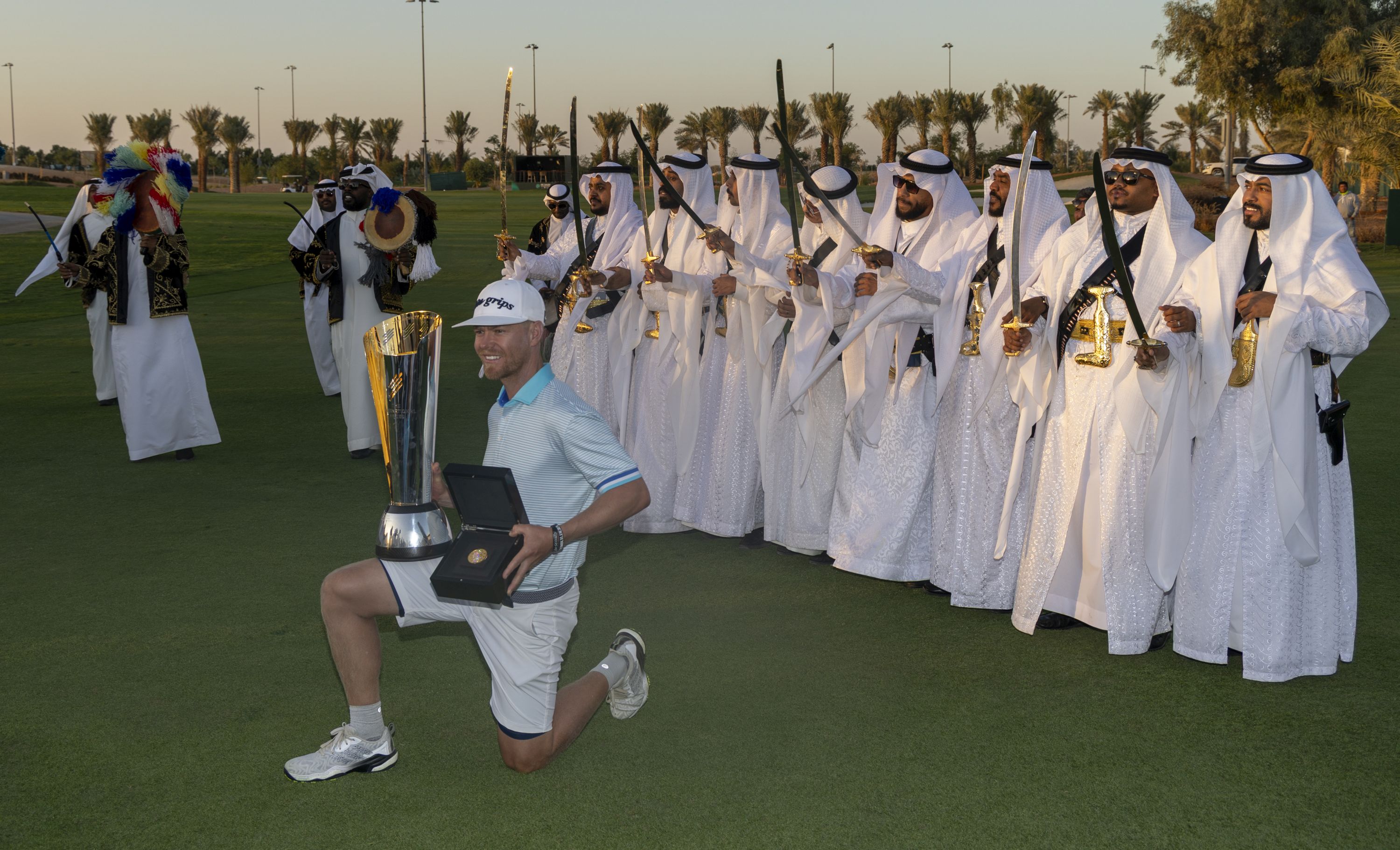
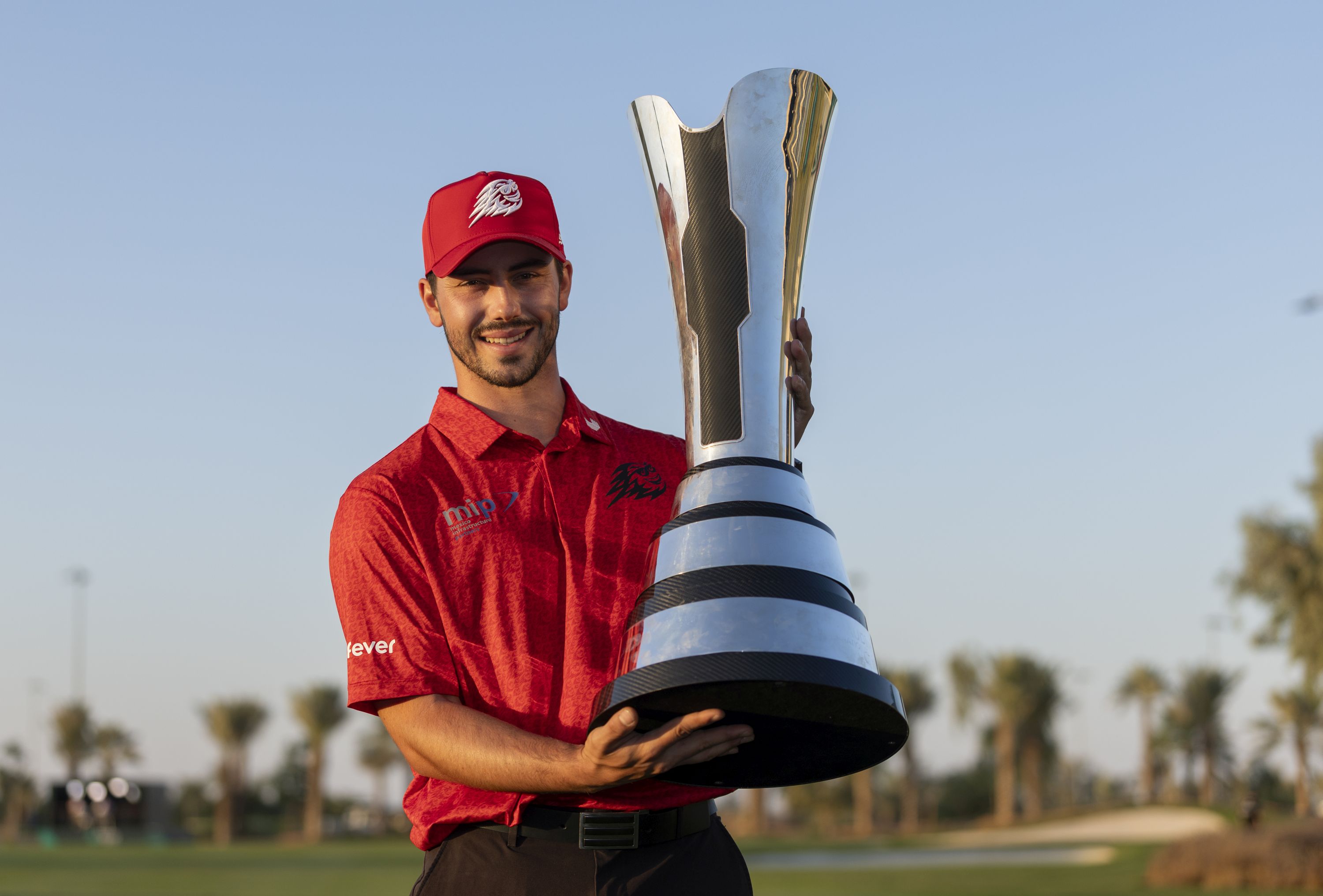



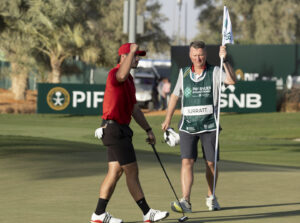
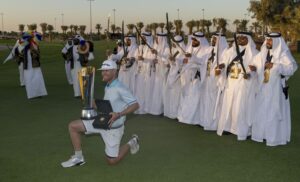


Recent Comments